|
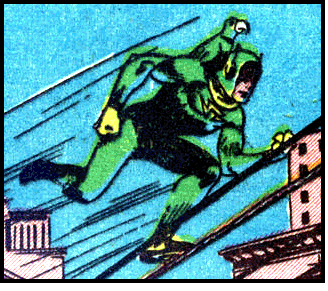 Air Wave: 1942, Detective Comics #60. Air Wave is one of the heroes who is a lawyer in his normal identity and decides to also fight crime in a costume. In this case he's really D.A. Larry Jordan. He has no innate powers, but his costume has skates in the boots that allow him to cruise along power lines and such and he has radios in his ear pieces. He is partnered by the parrot Static who like many of the animal side-kicks, shows unusually high intelligence. He fought mostly normal criminals and spies but also a few more coloful foes such as the Talker, the Parrot, and Dr. Silence. Despite his relative obscurity today, he was a successful back-up hero, lasting for six years. Air Wave: 1942, Detective Comics #60. Air Wave is one of the heroes who is a lawyer in his normal identity and decides to also fight crime in a costume. In this case he's really D.A. Larry Jordan. He has no innate powers, but his costume has skates in the boots that allow him to cruise along power lines and such and he has radios in his ear pieces. He is partnered by the parrot Static who like many of the animal side-kicks, shows unusually high intelligence. He fought mostly normal criminals and spies but also a few more coloful foes such as the Talker, the Parrot, and Dr. Silence. Despite his relative obscurity today, he was a successful back-up hero, lasting for six years.
Jack Andrews: 1935, New Fun #1. Jack Andrews is your typical comicbook athlete and high schooler, ie in addition to being a champion all round 4-star athlete, he finds himself embroiled in fighting crooks and such on and off the field and court.
Aquaman: 1941, More Fun #73. The Golden Age Aquaman is alike and substantially different from the Silver-Age one. The readers aren't told his name although his father is supposedly a famous undersea explorer. His mother died when he was a baby, but no hint that she was not a normal human. His father discovered the ruins of an undersea city at great depths which he was convinced was Atlantis. He managed to make a water-proof home in one of the buildings and lived there discovering ancient texts and devices. From them, he was able to teach his son how to breathe underwater, and using the power of the oceans to make himself strong and fast. This and "a hundred scientific secrets" transformed his son into the hero Aquaman. Like his modern counterpart, he can communicate with sea life, is incredibly strong and fast. Many of his foes were pirates and thieves, a recurring one being Black Jack the Modern Pirate. He is sometimes helped by the incredibly intelligent sea lion Ark and detective Phineas Pike aka the Sea Sleuth. Visually, he's identical to his Silver-Age counterpart with the exception of his gloves being yellow.
Armstrong of the Army: 1941, Star Spangled Comics #1. Lieutenant Armstrong is an agent U.S. Army Intelligence and flies the world over to ferret out spies, enemy plots, and to protect and steal secret weapons depending whose side the weapons originally are for. He's a talented pilot and more than capable with his fists. Two of his adventures take sci-fi overtones as in one he finds himself defending the inventor or a "time gun", a weapon that fires a ray that ages whatever it touches and another to take out the secret weapon of a "sand gun" which fires sand into enemy planes flying overhead. That one almost gets him eaten by sharks
 Atom: 1940, All-American Comics #19. Puny and short, Al Pratt is tired of being teased because of his five-foot-height and despondent over not impressing Mary, the girl of his dreams. He even buys a bum dinner just so he'll have someone to talk to. However, the bum turns out to be a former trainer of boxing agrees to train Al how to fight. A year of training on Al's uncle's farm, Al returns as a changed man: muscular, all around good athlete and excellent fighter. He ends up becoming a crime-fighter. He is a founding member of the Justice Society of America (and its most consistent member besides Hawkman), describing himself as a sophomore at Calvin College. When war breaks out, he enlists in the Tank Corps. He eventually gained real super-strength and changed his costume to reflect the more science fiction sensibilities as opposed to his athletic roots. Atom: 1940, All-American Comics #19. Puny and short, Al Pratt is tired of being teased because of his five-foot-height and despondent over not impressing Mary, the girl of his dreams. He even buys a bum dinner just so he'll have someone to talk to. However, the bum turns out to be a former trainer of boxing agrees to train Al how to fight. A year of training on Al's uncle's farm, Al returns as a changed man: muscular, all around good athlete and excellent fighter. He ends up becoming a crime-fighter. He is a founding member of the Justice Society of America (and its most consistent member besides Hawkman), describing himself as a sophomore at Calvin College. When war breaks out, he enlists in the Tank Corps. He eventually gained real super-strength and changed his costume to reflect the more science fiction sensibilities as opposed to his athletic roots.
Tony Barrett: 1948, All-American Western #103. In the Old West, “Tony” Barrett drives the Overland Coach out of Laredo and fights the usual Western bad guys along the way. However, Tony is a she: blonde and spirited, sporting a buckskin top and jeans. Sometimes she is helped by her younger brother Billy.
Batman: 1939, Detective Comics #27. When he was a child, Bruce Wayne witnesses his parents being shot and killed by a mugger. He devotes his life to training his mind and body to peak performance in order to fight crime. He's at a loss as to how when a bat crashes through his window, inspiring him to become a figure of terror for crooks. In early issues, he carries and uses a gun as well as having his own private plane equipped with guns. Eventually, he shuns the guns and takes on a teen sidekick in Robin (see individual entry). Batman is also an honorary member of the Justice Society of America. He eventually learns of the mugger's identity is Joe Chill and reveals himself to him. Chill flees to his gangster friends and reveals that he is the cause of Batman coming into being. Most of the crooks had spent time in prison and in anger gun down Chill before they even think to get from him Batman's identity.
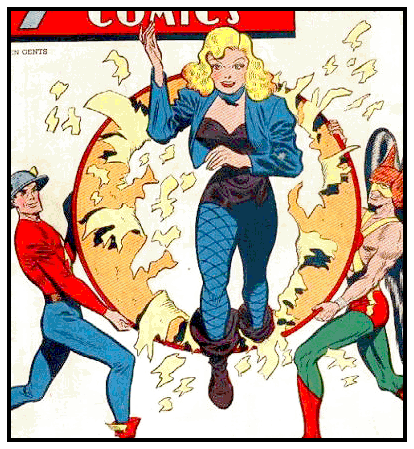 Black Canary: 1947, Flash Comics #86 (DC). Raven haired flower shop owner Dinah Drake puts on a blonde wig and black costume to fight crime. She is a good fighter and knows judo. When she first debuts, she helps out the JSA member Johnny Thunder. Later, she often helps out private eye Larry Lance with his cases who is enamored with Black Canary, but only sees Dinah as a friend. She helps out the Justice Society (All-Star #38) and is made Honorary Member. Created by Robert Kanigher, Carmine Infantino, and Joe Giella. NOTE: Both in Flash Comics and the Justice Society stories in All-Star, she edged Johnny Thunder out. Black Canary: 1947, Flash Comics #86 (DC). Raven haired flower shop owner Dinah Drake puts on a blonde wig and black costume to fight crime. She is a good fighter and knows judo. When she first debuts, she helps out the JSA member Johnny Thunder. Later, she often helps out private eye Larry Lance with his cases who is enamored with Black Canary, but only sees Dinah as a friend. She helps out the Justice Society (All-Star #38) and is made Honorary Member. Created by Robert Kanigher, Carmine Infantino, and Joe Giella. NOTE: Both in Flash Comics and the Justice Society stories in All-Star, she edged Johnny Thunder out.
Black Pirate: 1940, Action Comics #23. In the late 16th Century, English nobleman Jon Valor bands together a group of likeminded men to go to sea as pirates in service of the Crown. To this end, he puts on a mask and becomes the Black Pirate. In addition to preying on evil pirates and enemies of England, they also had more fantastic Burroughs style adventures.
Bobby and Binks: 1935, New Fun #1. Boy and girl Bobby and Binks are school children who look into a magic crystal which transports them to various time periods in the past such as the time of the Pharaohs and ancient Greece and Rome.
Boy Commandos: 1942, Detective Comics #64. The Boy Commandos are an international group of orphans hanging around an American unit in England during WW II. American Captain Rip Carter trains them in fighting and schooling, makes use of them as a special commando unit. The boys are American street tough Brooklyn (American street tough), Andre Chavard (French), Alfy Twidgett (British), and Jan Haasan (Dutch).
Bradley Boys: 1936, More Fun Comics #13. Tom and Jack Bradley are adventurous young men, wherever they go, adventure seemed to follow, no matter how commonplace the locale or plans. Tom is fair haired and Jack brunet.
Slam Bradley: 1937, Detective Comics #1. Slam Bradley is a two-fisted tough private detective. His partner is Shorty Morgan. In addition to fighting the normal bad type of bad guys that fiction detectives face, some of his adventures took on more science-fiction overtones. NOTE: Created by Jerry Siegel and Joe Shuster.
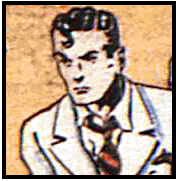 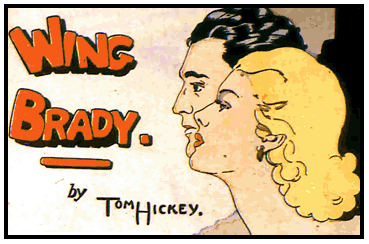 Wing Brady: 1935, New Fun #1. Wing Brady is with the French Foreign Legion and is helped in his adventures by his friend Slim. He can fly a plane, ride a horse, fight and shoot with the best of them. Wing Brady: 1935, New Fun #1. Wing Brady is with the French Foreign Legion and is helped in his adventures by his friend Slim. He can fly a plane, ride a horse, fight and shoot with the best of them.
After a harrowing adventure with Lynn Harding in the desert. The two fall in love while in Africa but are hampered by his adventures plus her being from one of the wealthiest familes in England. Because of his successes, he's promoted to Lieutenant. He's also champion boxer of his batallion.
Tom Brent: 1938, New Adventure Comics #28. Tom is a U.S. Naval officer on the S.S. Cory which allows him to have various adventures in exotic locales around the world against a variety of criminals.
Biff Brody and Pop Beaner: 1938, More Fun #31. Biff is a detective or adventurer of some sorts. He and Pop have a near miss with a milk truck,which is then demolished by some crooks. They track down and capture the gang and with the reward money buy the farmer a new truck.
Biff Bronson: 1939, More Fun Comics #43. Biff and pal Dan Druff are two footloose and fancy free young men that travel the country and fight crime and solve mysteries though prone to be a bit more fists first, deducting second. They are hired as guards in one story and another, Biff turns down a job offer with the FBI, rather staying “freelance” but it's possible they are living off of relatives' moneys and doing it for fun as it's mentioned that Biff has an ailing mother in a sanitorium and he has an uncle Jim while Dan's mom does show up. When they are at home, they are housemates. Their adventures have them preventing assassinations, fighting mad scientists, dictators, and busting the more common criminals as well.
Buzz Brown: 1938, More Fun Comics #30. Buzz is the orphan son of an Alaskan trader and his Inuit wife. Finding life difficult in the States for a boy with no home, he has stowed on a ship to China, discovered and been tossed overboard which is where the story begins, him floundering in the ocean. He's rescued Sandy MacDonald, tall hunky blond fellow in a sail boat and the two then run afowl of the pirate Captain Scudd. The story ends with Scudd about to gun the two heroes and his mutinous crew down in a hail of macine gun bullets.
The Buccaneer: 1938, More Fun Comics #32-51. Danny Stone is a young sailor around the time of the golden-age of piracy who becomes captain of the Serpent after the accidental death of the captain. His best friend Daneo becomes first mate. As the previous captain used the ship to transport slaves, Stone finds himself running against slavers, earning the love of the Governor's daughter Rina, helping a prince win back his throne from a look-alike imposter ala Dumas' “Man in the Iron Mask”. In the end, he weds Rina and gives command of the Serpent fo Daneo.
Buckskin Jim: 1935, New Fun Comics: A lad in the Old West, he wears a buckskin outfit and a coonskin hat. He's plucky, clever, good with rifle and knife, and able to hold his own against many adults. Even when he's fighting Native American Indians, he's not especially cruel, willing to risk his life to save an unconscious foe.
Don Caballero: 1951, All-Star Western #58. A swashbuckling swordsman, he's a more colorful and un-masked version of Zorro.
Cap'n Erik: 1935 New Fun #1. Cap'n Erik is the captain of the masted schooner the Viking which engages in such things as seal hunting. He has his crew and a stowaway orphan named Rags.
Captain Compass: 1948, Star Spangled Comics #83. Captain Mark Compass captains ships and works as a special investigator for Penny Steamship Lines where he's a skilled detective and master of observation and reasoning. Captain Compass would make sporadic appearances in reprints and guest-appearances in various comics into the 1970s and early 80s.
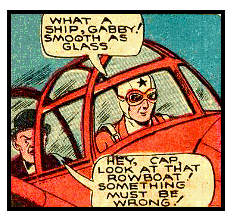 Captain Desmo: 1938, New Adventure Comics #26. Captain Desmo is a heroic aviator. He was the youngest flyer in the First World War and continues to fly various missions that promise adventure. He stands out by constantly wearing an aviator's cap with a star on it, giving him a superhero type look at this early date. On one early mission he saves Gabby McGuire who becomes his sidekick. Major McAlistair of His Majesty's Lancers serves as contact for many of his missions most of which took place in India and the far East. For some unknown reason, Desmo wears his cowl all the time: on a mission, lounging in the house in casual clothes, asleep, etc. There seems to be a reason for it, as Gabby questions Desmo about it, but it remains unrevealed. Would think it would make things difficult when he's supposed to be undercover or investigating discretely. On the other hand, Gabby isn't much to talk as he wears his bowler hat even when bathing. Captain Desmo: 1938, New Adventure Comics #26. Captain Desmo is a heroic aviator. He was the youngest flyer in the First World War and continues to fly various missions that promise adventure. He stands out by constantly wearing an aviator's cap with a star on it, giving him a superhero type look at this early date. On one early mission he saves Gabby McGuire who becomes his sidekick. Major McAlistair of His Majesty's Lancers serves as contact for many of his missions most of which took place in India and the far East. For some unknown reason, Desmo wears his cowl all the time: on a mission, lounging in the house in casual clothes, asleep, etc. There seems to be a reason for it, as Gabby questions Desmo about it, but it remains unrevealed. Would think it would make things difficult when he's supposed to be undercover or investigating discretely. On the other hand, Gabby isn't much to talk as he wears his bowler hat even when bathing.
Captain Grim: 1935, New Fun Comics #3. A boat captain in the South Seas, investigating the mysterious gray death that kills without leaving a mark as well as his crew that went missing on the Island of Missing Mena, running across treacherous white men and natives.
Captain Jim of the Texas Rangers: 1936, New Comics #2. Originally called "Bill", Captain Jim is of the Texas Rangers in the Old West, doing the typical cowboy hero stuff.
Captain Quick: New Adventure Comics. Kendal Quick is an adventurous swashbuckling sea captain in the Middle Ages fighting against the Spanish and other enemies of the crown. His love is Marjorie, daughter of Lord Barlow. His ship is the Bonnie Bess. He is knighted and then commissioned for more missions, duty to country upsetting his desire to marry.
Detective Sergeant Carey: 1937, New Adventure Comics v2n2 (14). “Detective Sergeant Carey of the Chinatown Squad” and his assistant, the clumsy, corpulant Sleepy are sent to invetigate a murder at No 13 Lane of the Thousand Bleeding Dragons. Despite their beat, the duo aren't exactly broadminded of Chinatown and its residents.
Clip Carson: 1939, Action Comics #14. Clip is your standard adventurer and soldier of fortune. He travels the globe having adventures with his archaeologist pal Jim Blake in his first story arc as well as numerous other old friends who seem to find themselves in strange jams. In addition to regular adventures of that type, he also veers into the more fantastic, facing off against mad scientists and villains with actual code names. He's last seen becoming a foreign correspondent at the outbreak of America's involvement in World War II. Note: Early stories done by Bob Kane and possibly Bill Finger.
Steve Carson: 1936, New Comics #2. Steve Carson is a crack shot and ace undercover detective and the federal man of the “Federal Men” strip. In one fantastic adventure, he fights criminals using gigantic robots and were stationed on a secret island off the coast of New York! In a story within a story sequence by a Professor Grant in New Adventure Comics #12, we see the Federal Men of Tomorrow, featuring federal man Jor-L from 3000 AD! NOTE: Created by Siegel and Shuster.
King Carter: 1939, More Fun Comics #49. King is a wealthy oil man (somewhere in the American West presumably since he wears a stetson and cowboy boots) as well as a world adventurer and collector of precious gems and stones. His buddy is newsreel cameraman Red Rogers.
Steve Carter: 1947, Gang Busters #1. Steve is an agent of the FBI, appearing in the feature titled "Federal Agent".
Cotton Carver: 1939, Adventure Comics #35. Cotton is an explorer and adventurer. He finds a Mayan tribe in the Antarctic and who take him to their kingdom beneath the ice. From there, he travels around the globe, below the surface, on the surface and above. He has a knack for meeting up with enemies and converting them to allies. His girlfriend is Deela who is made queen of Burlandia, one of the many lost kingdoms Carver comes across.
Cabbie Casey: 1946, More Fun Comics #108. Before and after the War, Cabbie is a good-natured freelance cab driver who stumbles into various adventures.
Mr. Chang: 1937, Detective Comics #2. Mr. Chang is a wealthy man with a hobby of the science of criminology and aides the police with their cases. He is helped by his servant Wu. He speaks in stereotypical Charlie Chan fashion, but is an able detective and fighter, willing to kill if necessary.
Congo Bill: 1940, More Fun Comics #56. Congo Bill is your fairly standard big game hunter and explorer out of Africa. Notable for his longevity (until 1961) as well as appearing in his own movie serial. 1954, in Action Comics #191, he gains a kid sidekick in Janu the Jungle Boy. Bill adopts him as a ward after Janu's father is killed by a tiger. 1959, Action Comics #248, Congo Bill becomes Congorilla.
Steve Conrad: New Adventure Comics. Steve's an inventor and scientist and marooned on Dolorosa Isle along with Captain Hugo Judd, Myra Rutherford and Professor Bromberg. Unfortunately on the island is the tough and ruthless Devachan, leader of the Sea People or as he calls himself “the Great Devachan of Dolorosa”. Devachan does seem to be a title as opposed to a name.
Cliff Cornwall: 1940, Flash Comics #1. Cliff is an FBI agent who takes on various cases for the U. S. Military. He is also a Reserve Army Air Corps officer. He shows himself to be a good pilot, deep sea diver amongst standard fighting, detective, and shooting skills. On his first case he meets Lys Valliere who goes on to accompany him on several cases and serve as love interest.
Cosmo: 1937, Detective Comics #1. Cosmo, aka the Phantom of Disguise is an ace detective and super-disguise artist. He's world famous, on call to the police, various intelligence agencies as well as Scotland Yard.
Crimson Avenger & Wing: 1938, Detective Comics #20. Originally a more blatant riff of the Green Hornet, Lee Travis put on hat, mask and cloak and fought crime with a gas gun as the Crimson with only his Chinese servant Wing knowing his identity. By day, he was the wealthy young publisher of the newspaper The Globe Leader. Eventually, he traded in his pulp look and he put on a red and yellow form fitting costume with Wing wearing an inverse version of yellow and red. Sadly, during this phase, Wing was a very stereotypical caricature playing up the silly aspect, speaking pidgin English and cracking jokes, buck teeth and his costume being ill-fitting, instead of tight briefs, he wore boxers. And, while the Crimson Avenger was counted as a member of the Seven Soldiers of Victory, Wing only helped the Crimson Avenger out with his side of those cases, not appearing with the whole team.
Dale Daring: New Adventure Comics. Dale's father is kidnapped in China by bandit general Tsin Lee because he knows the location of a secreted cache of weapons and ammunition. Dale, dashing Captain Brewster of the Marines, and a native guide and the captain's servant named Ali work to free him.
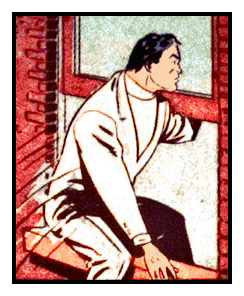 Young Doc Davis: 1941, World's Best Comics #1. Young Doc Davis is the new doctor at Metropolis Hospital which somehow leads to himself getting involved in solving mysteries, fighting yellow menaces and smuggling rings. Young Doc Davis: 1941, World's Best Comics #1. Young Doc Davis is the new doctor at Metropolis Hospital which somehow leads to himself getting involved in solving mysteries, fighting yellow menaces and smuggling rings.
Chuck Dawson: 1938, Action Comics #1. "When Charles Dawson, owner of the Circle-D Ranch is killed in a bloody Texas Range war, his young son and only heir goes to live with an uncle, a horse raiser in Wyoming. The boy, known as "Chuck", grows to manhood with the build of an athlete and an almost uncanny skill with the rifle and six-gun. Chuck now begins to think about taking up the fight against the crooked cattlemen who killed his father…"
Allan de Beaufort: 1935, New Comics #1. Allan aka the "Iron Man," is a knight in full plate amor from the Fourth Crusade and beomes a Knight Templar.
Midshipman Jack Dewey: 1935, New Fun #2. The lad is a midshipman on the United States sloop “Hornet” which hunts pirates. And, being a nautical adventure ship, they find them.
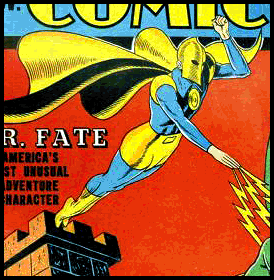 Dr. Fate: 1940, More Fun Comics #55. When his father is killed exploring a pyramid, the boy Kent Nelson is raised by the alien sorcerer Nabu. When he reaches adulthood, he is a master of magic, occult and alchemy, able to covert energy into matter and vice versa. He lives in a forbidding brick tower in Salem Massachusetts. His girlfriend is Inza Kramer. Dr. Fate is a founding member of the JSA. NOTE: With his helmet and tights, Dr. Fate is one of the more striking and different looking magician heroes of the time. Dr. Fate: 1940, More Fun Comics #55. When his father is killed exploring a pyramid, the boy Kent Nelson is raised by the alien sorcerer Nabu. When he reaches adulthood, he is a master of magic, occult and alchemy, able to covert energy into matter and vice versa. He lives in a forbidding brick tower in Salem Massachusetts. His girlfriend is Inza Kramer. Dr. Fate is a founding member of the JSA. NOTE: With his helmet and tights, Dr. Fate is one of the more striking and different looking magician heroes of the time.
Dr. Mid-nite: 1941, All-American Comics #25. Surgeon Charles McNider is blinded while he's testifying against a racketeer. One night afterwards, an owl crashes through his window and McNider is so startled he rips off his bandages and discovers that he can see in the dark and with greater range than most have during the day. He puts on a costume with dark lenses that allow him to see during the day as well and develops black-out bombs that cause thick black smoke that only he can see through. He adopts the owl and names him Hooty. He joins the Justice Society of America shortly after its founding. His assistant and nurse is Myra Mason who is generally unaware of McNider's dual identity (though in one JSA adventure, she and the other girlfriends would dress up as female counterparts of the male heroes).
Dr. Occult: 1935, New Fun #6. A mystic detective, he is both a two-fisted detective and possesses some magic powers and magically powered amulet. His girlfriend and assistant for one serial is Rose Psychic. He also acts on behalf of the mystic Seven, presumably where he got his training and abilities. He briefly wears a costume and uses a magic sword, In one installment, he was published by Centaur as Dr. Mystic. Has a butler named Jenkins, later called Custer. In some stories his symbol is not a circle but looks like a small key of some type. While not very effective against all vampires, it works against werewolves, paralyzing them. Sgt./Captain Ellsworth (again, an inconsistancy in the stories) often contacts him about cases that are out of the ordinary and might fall under supernatural, though some fall more under super science.
Henri Duval: 1935, New Fun Comics #6. A French Musketeer style soldier of fortune circa 17th century France. NOTE: Created by Siegel and Shuster.
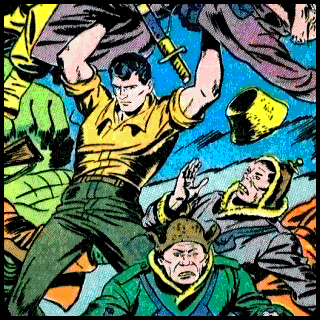 Johnny Everyman: 1944, World's Finest #15. During the War, Johnny operated mostly as an undercover agent. His adventures took him around the world, often facing/highlighting the issues facing various peoples and ethnicities. After the War, he tackled racial and cultural prejudices and bigotry at home, often telling inspiring stories to youths. Johnny had no powers but was a good fighter as well as a progressive thinker. Johnny Everyman: 1944, World's Finest #15. During the War, Johnny operated mostly as an undercover agent. His adventures took him around the world, often facing/highlighting the issues facing various peoples and ethnicities. After the War, he tackled racial and cultural prejudices and bigotry at home, often telling inspiring stories to youths. Johnny had no powers but was a good fighter as well as a progressive thinker.
 Flash: 1940, Flash Comics #1. Jay Garrick is a college senior, and a bit on the slackard side, to be honest. He's a bench warmer on the Football Squad. And, even though he's a brilliant chemistry student it's against the coach's orders, he takes a break while separating the elements of “hard water” for a chemistry experiment to smoke a cigarrette. He accidentally knocks over the experiment and breathes in the vapors which knocks him unconscious. When he finally recovers, he discovers he has super speed which he first uses to show off and impress his girlfriend Joan Williams such as winning a football game pretty much by himself. Upon graduating from college, he finds a purpose in using his gift of super speed in fighting crime and makes a name for himself. In the first several issues, he's inconsistent with protecting his identity. He often operates invisibly by moving super fast, and his actions being attributed to freakish winds or ghosts. However, he also performs publicly in his Garrick identity on the football field and setting outlandish records while rooting out gambling racketeers. His girlfriend Joan knows his identity and tells one person that Garrick is almost as fast as the Flash and it would not be fair for him to compete with other athletes. He is a founding member of the Justice Society of America. Flash: 1940, Flash Comics #1. Jay Garrick is a college senior, and a bit on the slackard side, to be honest. He's a bench warmer on the Football Squad. And, even though he's a brilliant chemistry student it's against the coach's orders, he takes a break while separating the elements of “hard water” for a chemistry experiment to smoke a cigarrette. He accidentally knocks over the experiment and breathes in the vapors which knocks him unconscious. When he finally recovers, he discovers he has super speed which he first uses to show off and impress his girlfriend Joan Williams such as winning a football game pretty much by himself. Upon graduating from college, he finds a purpose in using his gift of super speed in fighting crime and makes a name for himself. In the first several issues, he's inconsistent with protecting his identity. He often operates invisibly by moving super fast, and his actions being attributed to freakish winds or ghosts. However, he also performs publicly in his Garrick identity on the football field and setting outlandish records while rooting out gambling racketeers. His girlfriend Joan knows his identity and tells one person that Garrick is almost as fast as the Flash and it would not be fair for him to compete with other athletes. He is a founding member of the Justice Society of America.
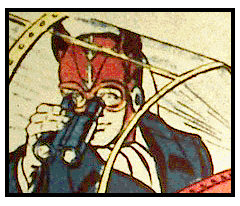 Flying Fox: 1938, More Fun Comics #37. The Flying Fox is a heroic aviator type. His real name is Rex Darrell, a pilot and hired investigator of some sort whose adventures take him to the four corners of the globe. His aviator's cowl has fox-like ears, so he does have a costume of sorts. Flying Fox: 1938, More Fun Comics #37. The Flying Fox is a heroic aviator type. His real name is Rex Darrell, a pilot and hired investigator of some sort whose adventures take him to the four corners of the globe. His aviator's cowl has fox-like ears, so he does have a costume of sorts.
Jim Gale: 1936, New Comics #1. Jim is a professional gambler and part-time adventurer. Not above letting twin six-shooters help solve his problems. He's helped by Kim, a Chinese man who can quickly throw a knife with unerring accuracy. Kim works for a mysterious "Lady in Black" revealed to be Louise Vallen. She and Jim fall for each other hard but she's dismayed to find he's a gambler. He plans on giving it up, using the reward money for returning a stolen pearl necklace to her for one last gamble, hoping to strike big and be on equal footing financially so they can get married. He loses. So, he heads out to get a real job, to earn money the hard way so that he can return being worthy of marrying her. And for some reason, Kim goes along. Which is the state of things when the story just ends.
Gay Ghost: 1942, Sensation Comics #1. In the year 1700, Keith Everett, Earl of Strethmere in Ireland, is waylaid and killed on his way to Ulster to visit his love Deborah Wallace. He is tasked to return to Earth to fight evil when Deborah dies for good. However, she keeps getting reincarnated. In 1941, Charles Collins, the boyfriend of her direct descendent and latest incarnation, is killed. Keith enters Charles' body and re-animates it. As the Gay Ghost, he wears the clothes he was wearing when he died and has various ghostly physical powers: strength, flight, become intangible, and whatever else the story needs.
Ghost Patrol: 1942, Flash Comics #29. Fred, Pedro, and Slim are fliers for the French Foreign Legion. Realizing they have been ordered to bomb an innocent village, they drop their bombs in the desert. But their plain has been rigged and it explodes and kills them. They continue to fight as ghosts. They can do various ghostly things while visible and invisible. However, when they materialize and are solid, they are vulnerable to harm.
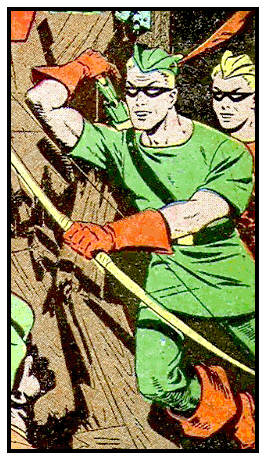 Green Arrow: 1941, More Fun Comics #73. Oliver Queen is an idle millionaire with an interest in Indian lore and artifacts. He travels to the remote Lost Mesa in the hope of obtaining such when he meets Roy Harper and Quoag. Roy was marooned and orphaned on Lost Mesa by a plane crash, the only other survivor being the family servant and Native American Quoag. While marooned, Roy trained himself to be an expert with bow and arrow. Oliver hooks up with the duo about the same time that crooks find Oliver. In the ensuing fight, Quoag is killed. Oliver and Roy continue to fight crime as Green Arrow and Speedy. They are both members of The Seven Soldiers of Victory. NOTE: The golden-age Green Arrow did not use trick arrows to a large degree. Also, his hair was brown while Speedy's was blonde. In 1958, Jack Kirby gave us the more Batman tripped out version of Green Arrow and with a new origin. Green Arrow: 1941, More Fun Comics #73. Oliver Queen is an idle millionaire with an interest in Indian lore and artifacts. He travels to the remote Lost Mesa in the hope of obtaining such when he meets Roy Harper and Quoag. Roy was marooned and orphaned on Lost Mesa by a plane crash, the only other survivor being the family servant and Native American Quoag. While marooned, Roy trained himself to be an expert with bow and arrow. Oliver hooks up with the duo about the same time that crooks find Oliver. In the ensuing fight, Quoag is killed. Oliver and Roy continue to fight crime as Green Arrow and Speedy. They are both members of The Seven Soldiers of Victory. NOTE: The golden-age Green Arrow did not use trick arrows to a large degree. Also, his hair was brown while Speedy's was blonde. In 1958, Jack Kirby gave us the more Batman tripped out version of Green Arrow and with a new origin.
Green Lantern: 1940, All-American Comics #16. Engineer Alan Scott is the sole survivor of a sabotaged train wreck. He finds that he survived by holding onto a strange green lantern. The lantern tells him the story of its origin, that it first fell to Earth as a meteor centuries ago and that it was prophesied to flame three times: once to bring death, twice to bring life, and a third time to bring power. The first time was when a man crafted the meteor into an Asian lamp, he was killed by villagers and the lamp flared killing them. The second time, a mental patient fashioned it into a modern railroad lamp and it restored his sanity, and to Alan Scott, it gives its power. Alan forms a ring that he can charge and he goes after the murderers that sabotaged the train. Then, he puts on a costume so that people will remember him. Originally, the ring only had power over metal, hence the wood weakness. Eventually, wood became its only weakness. Green Lantern would be sidekicked by jalopey taxi-cab driver Dolby Dickles who also served as comedy relief. Green Lantern was a founding member of the Justice Society of America. Among his notable villains are the Sportsmaster, Solomon Grundy, the Harlequin (a woman who committed crimes solely to get his attention and be close to him).
Guardian and the Newsboy Legion: 1942, Star-Spangled Comics #7. Tommy, Scrapper, Gabby, and Big Words are a tough kid gang in Suicide Slum, the worst section of town. They are caught stealing and are about to be sent to reform school when the local beat police officer Jim Harper volunteers to become their legal guardian. When Harper is beaten up by some local toughs, he decides to step outside the law. He breaks into a costume suit, puts together a costume complete with shield and leaves money for it. He gets his payback and continues to fight crime as both Harper and the Guardian, half the time spent getting the boys out of some trouble they find themselves. The Newsboys suspect Harper as being the Guardian but cannot ever quite prove it. Scholarly Big Words is tall and thin and revealed to be the oldest of the kids. There are a couple of mentions of him being stronger than he appears, surprising even himself at times.
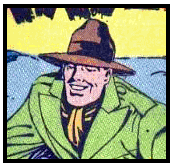 Guerilla: 1943, Adventure #84. Mike Gibbs is a joking reporter stationed in Paris in 1940. When the Germans invade he befriends Marie Hwart, organizer of the local Underground. He sheds his old identity and is known only as the Guerilla, stalking Nazis and other Axis forces and serving as a symbol to those suffering under Axis tyranny. While the blurb to his story suggests that he is no longer known as Mike Gibbs, he doesn't wear a mask or costume and the name of the strip is "Mike Gibbs, Guerilla". Guerilla: 1943, Adventure #84. Mike Gibbs is a joking reporter stationed in Paris in 1940. When the Germans invade he befriends Marie Hwart, organizer of the local Underground. He sheds his old identity and is known only as the Guerilla, stalking Nazis and other Axis forces and serving as a symbol to those suffering under Axis tyranny. While the blurb to his story suggests that he is no longer known as Mike Gibbs, he doesn't wear a mask or costume and the name of the strip is "Mike Gibbs, Guerilla".
Brad Hardy: 1935, New Comics #3. When Brad Hardy's girl Lorraine Lewis is kidnapped by forces of the Underground Kingdom, he sets out to find and rescue her. He gains an ally in Prince Karados who has some magical abilities. Rescuing her is not a straight forward affair as they travel and have various adventures in the process. They get involved in a war between Snake Men and Rat Men, find Lorraine in the hands of the Black Magician of Dre. They free her but she gets captured again. The adventures seem to be a cross between that of Edgar Rice Burroughs and the adventures of Raymond's Flash Gordon.
Hop Harrigan: 1939, All-American Comics #1. Hop was more or less orphaned when his famous pilot father disappeared on a trip to see his wife in South America. Hop was then raised by his neighbor who tried to gain legal guardianship in order to swindle him of his inheritance, of which the neighbor was successful. As a teen he left the man in his father's biplane, saves the life of mechanic Tank/Ikky Tinker and the two became friends. Tinker is the one who gave Hop his nickname. They befriend the pilot Prop Wash who was the one that had accidentally endangered Tank and form the All-American Aviation Company. Hop's girlfriend is Gerry, an heiress that was briefly passing herself off as a lad named Jerry. For a few months he fought crime as the costumed Guardian Angel. During the War, the three would join the Army Air Corps. Afterwards, Hop adopted the id of the Black Lamp. On Radio, he flew the fictional plane CX4. NOTE: Though preceeded in newspaper comic strips by several long running fliers, he is arguably the first successful ongoing comic book aviation hero.
Hope Hazard: 1937, Detective Comics #3. The beautiful Hope is an agent of the FBI and is pursuing some missing airplanes with pilot Bill Littlejohn (!) only to discover a subterranean mad scientist by the name of Xavier is behind it. Story ends on a cliff-hanger. When “a” Hope Hazard does return it's in More Fun Comics below. NOTE: Cannot help but notice the pilot's name. One of Doc Savage's aides is William Harper Littlejohn, though he's called Johnny not Bill. Maybe he's undercover?
Hope Hazard II: 1938, More Fun Comics #30. “Hope Hazard inherits Fenton Manor from a little known great aunt and she and her father, formerly of the secret service, give up a roving life and plan to settle down.” They end up tangling with international jewel thieves that live next door. She meets them as Baron Serge Rasoff and the exotic Princess Fiesole,but the authorities recognize them as “Nifty Nick” and “Glamorous Kate”. A few holes in the story. NOTE: This Hope not only seems unrelated to the other, this version is also in the public domain unlike the other one.
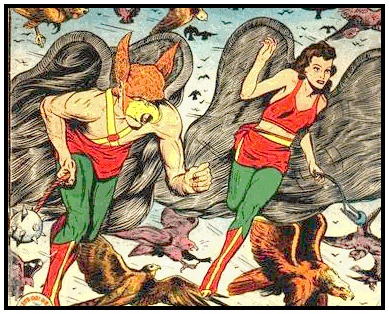 Hawkgirl: As Shiera Sanders: 1940, Flash Comics #1. When Shiera Sanders first appeared, it was as a supporting character and love interest of Carter Hall who is a reincarnation of Prince Khufu of ancient Egypt and she is supposed to be the reincarnation of Khufu's love (also originally named the very non-Egyptian name Shiera), both of whom were killed by Hath Set in those ancient days and who has also reincarnated. Shiera first appears in a variation of Hawkman's costume in All-Star Comics #5, 1941 as a ruse to trick some criminals and then to a masquerade ball in Flash Comics #24, 1941. From then, it became a semi-regular gig for her. As Hawkgirl, Shiera could fly. NOTE: Interestingly, the story in that issue of Flash Comics is called “Hawkwoman”. Hawkgirl: As Shiera Sanders: 1940, Flash Comics #1. When Shiera Sanders first appeared, it was as a supporting character and love interest of Carter Hall who is a reincarnation of Prince Khufu of ancient Egypt and she is supposed to be the reincarnation of Khufu's love (also originally named the very non-Egyptian name Shiera), both of whom were killed by Hath Set in those ancient days and who has also reincarnated. Shiera first appears in a variation of Hawkman's costume in All-Star Comics #5, 1941 as a ruse to trick some criminals and then to a masquerade ball in Flash Comics #24, 1941. From then, it became a semi-regular gig for her. As Hawkgirl, Shiera could fly. NOTE: Interestingly, the story in that issue of Flash Comics is called “Hawkwoman”.
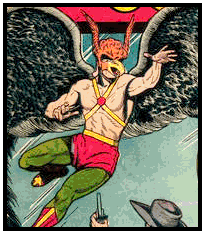 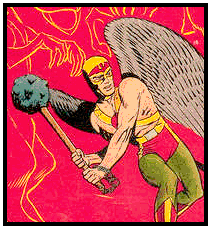 Hawkman: 1940, Flash Comics #1. Archaeologist Carter Hall has a realistic dream that he's the reincarnation of Prince Khufu of ancient Egypt and that he and Khufu's love are killed by the priest Hath-Set. The next day he meets Shiera Sanders who looks just like Khufu's love as well as discovering that their murderer has likewise been reincarnated as Dr. Hastor. Using ancient knowledge, he is able to make himself a pair of wings and an anti-gravity belt made of “ninth metal” that will allow him to fly. He is an avid collector of ancient weapons and proficient in them. Thus equipped, sets forth to bring his murderer and other criminals to justice. In the early days, he wasn't above killing his opponents if he felt their crimes merited it. He was a founding member of the Justice Society of America and its most consistent member. Hawkman: 1940, Flash Comics #1. Archaeologist Carter Hall has a realistic dream that he's the reincarnation of Prince Khufu of ancient Egypt and that he and Khufu's love are killed by the priest Hath-Set. The next day he meets Shiera Sanders who looks just like Khufu's love as well as discovering that their murderer has likewise been reincarnated as Dr. Hastor. Using ancient knowledge, he is able to make himself a pair of wings and an anti-gravity belt made of “ninth metal” that will allow him to fly. He is an avid collector of ancient weapons and proficient in them. Thus equipped, sets forth to bring his murderer and other criminals to justice. In the early days, he wasn't above killing his opponents if he felt their crimes merited it. He was a founding member of the Justice Society of America and its most consistent member.
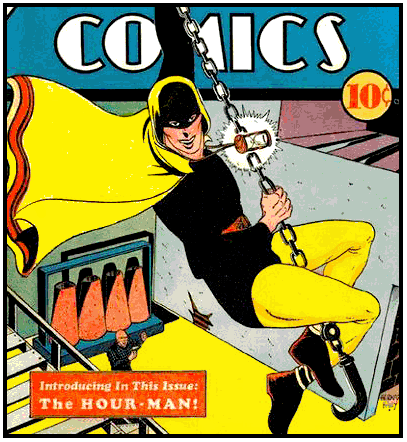
Hourman: 1940, Adventure Comics #48. Chemist Rex Tyler discovers a chemical which gives him incredible strength, endurance and speed for one hour. He calls it Miraclo, puts together a yellow and black costume and calls himself Hourman. He is sometimes sidekicked by Jimmy Martin and later the Minute-Men. He's a founding member of the Justice Society of America.
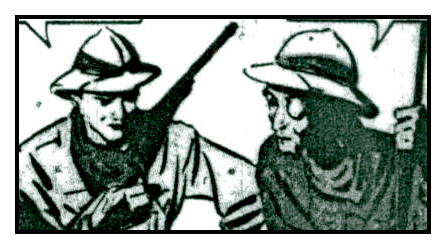 Tod Hunter: 1938, New Comics #27. Tod Hunter is the "Jungle Master" of the title. He's an explorer and hunter. He travels with his pal Tommy (who wears a monocle so you can tell them apart). They are searching for the "God of the Ruby Eye", legend because supposedly no one has seen this god or its people and lived. Tod Hunter: 1938, New Comics #27. Tod Hunter is the "Jungle Master" of the title. He's an explorer and hunter. He travels with his pal Tommy (who wears a monocle so you can tell them apart). They are searching for the "God of the Ruby Eye", legend because supposedly no one has seen this god or its people and lived.
Ivar: New Adventure Comics. Ivar leads an expedition of vikings in search of Sundgrid and has to rescue her from druids. Sundgrid is a Celt, daughter of Gudlief, the famous bard.
Johnny Quick: 1941, More Fun Comics #71. Johnny Chambers is the ace cameraman for “Sees-All Tells-All News”. Professor Gill teaches him the mathematical formula “3X2(9YZ)4A” that grants super-speed when recited. Johnny promptly makes a costume for himself and embarks on a crimefighting career. He's aided by the portly Tubby Watts who knows his secret. Eventually, Johnny Quick manages to use his speed to also fly. NOTE: Frequently drawn using multiple images of Johnny in a single panel to get across his speed, Johnny Quick was possibly the best executed speedster of the 1940s, deserving of his longevity of the time.
Jungle Boy: 1936, New Comics #4. The Jungle Boy is Bomba, but not the more famous Bomba, the Jungle Boy!
Justine Justis: 1937, New Adventure Comics #22. Justine is a blonde G-Woman, Operator 23, and supposedly the only female agent they have.
Sandy Kean: 1936, More Fun #11. Sandy Kean is a two-fisted but honest Radio Squad cop. In addition to busting criminals, he contends with a corrupt justice system in the city until the Governor himself has to come to the rescue before Kean is thrown into jail. NOTE: Strip initially called “Calling All Cars” then “Radio Squad”. Created by Siegel and Shuster.
King: 1940, Flash Comics #3. King Standish is one of those millionaire playboys who fights crime in a tux and mask when he's not in disguise ala the Phantom Detective. King is also a good lockpicker and marksman. His longest recurring villain is the jewel thief the Witch. The two obviously have romantic feelings for each other, and the King seems mainly interested in just foiling her crimes as opposed to actually capturing her. Another foe of his is the Scarlet Mermaid.
Paul Kirk, Manhunter (I): 1941, Adventure Comics #58. Paul Kirk is the "manhunter" of the title strip, a plain clothes investigator. He does not use the name as a code-name, it's just his general job description.
Lady Danger: 1948. Sensation Comics#84. Reporter Valerie Vaughn is an intrepid and daring reporter and is known as Lady Danger to her readers. Created by Robert Kanigher, Art by Bob Oksner.
Lando: 1941, America's Best Comics #1. Lando is a well-known stage magician but he also uses real magic to fight against criminals and threats such as pitting his magic against an evil witch doctor's. He faced a masked foe called the Hood and a monstrous creature called the Gargoyle. He is part of that magician hero fraternity who always seems to be dressed in formal wear with his head wear delineating that he is a magician, in his case a turban. As his strip had multiple artists, he had some slightly different looks. Sometimes, he had a mustache and possibly a beard, other times he was clean shaven. Sometimes, he appeared to wear a standard suit as opposed to a tux and sometimes he sported a cape. NOTE: America's Best Comics became World's Finest the next issue.
Johnnie Law: 1937, More Fun Comics #21. Johnnie Law is a rookie cop with a beat in the tenements of the Lower East Side. Saving the boy Tim from a fire, he is soon promoted to detective where he uses his guns and fists to help solve his cases. He lives at Mrs. Ashley's Boarding House and adopts Tim. His final published case is him pursuing a mad scientist who's enslaving people to serve as human bombs.
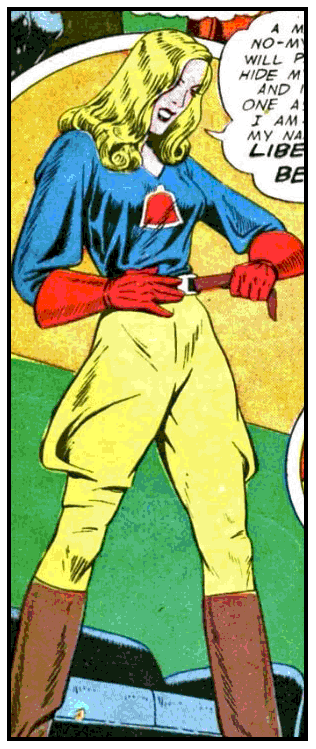 Liberty Belle: 1942, Boy Commandos #1. Libby Belle Lawrence is from Warsaw and finds herself fleeing country to country, ever one step ahead of the invading Nazis. By the time she reaches America, she's already famous for having swum the English Channel to escape France which she is able to parlay into a reporting gig. While vising the Liberty Bell, she's given a small replica by Tom Revere, a caretaker/watchman of the bell. She's motivated by the bell's symbol to create a costumed identity fashioned after the bell. When dangers and threats rear their heads, Tom rings the bell and through some kind of sympathetic magic connection, the replica she uses as a belt buckle vibrates. She doesn't wear a mask, relying on her eye-catching costume and Veronica Lake style haircut to serve as disguise enough. Liberty Belle: 1942, Boy Commandos #1. Libby Belle Lawrence is from Warsaw and finds herself fleeing country to country, ever one step ahead of the invading Nazis. By the time she reaches America, she's already famous for having swum the English Channel to escape France which she is able to parlay into a reporting gig. While vising the Liberty Bell, she's given a small replica by Tom Revere, a caretaker/watchman of the bell. She's motivated by the bell's symbol to create a costumed identity fashioned after the bell. When dangers and threats rear their heads, Tom rings the bell and through some kind of sympathetic magic connection, the replica she uses as a belt buckle vibrates. She doesn't wear a mask, relying on her eye-catching costume and Veronica Lake style haircut to serve as disguise enough.
Red Logan: 1938, More Fun #31. Logan is a crusading crime reporter, he works for the Times Courier..
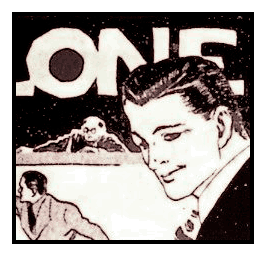 Steve Malone: 1938, Detective Comics #18. Steve Malone is a suave DA and decent detective. He enjoys the finer things in life such as dressing in tux and tails for a night at the opera. Steve Malone: 1938, Detective Comics #18. Steve Malone is a suave DA and decent detective. He enjoys the finer things in life such as dressing in tux and tails for a night at the opera.
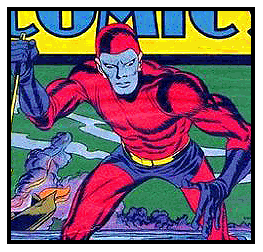 Manhunter (II): 1942, Adventure Comics #73. Paul Kirk is a big game hunter, is inspired by the death of Inspector Donovan. He decides to put on a costume and to use his skills to go after "the most dangerous game" - man, specifically criminals as well as enemy agents. He's called "Rick Nelson" at one point in the intro story, suggesting that name was changed after the fact, to link it to the previous Paul Kirk strip though the character isn't similar. Manhunter (II): 1942, Adventure Comics #73. Paul Kirk is a big game hunter, is inspired by the death of Inspector Donovan. He decides to put on a costume and to use his skills to go after "the most dangerous game" - man, specifically criminals as well as enemy agents. He's called "Rick Nelson" at one point in the intro story, suggesting that name was changed after the fact, to link it to the previous Paul Kirk strip though the character isn't similar.
Mark Marson: 1936, More Fun Comics v2n3 (15): Mark Marson is of the Interplanetary Police and tasked with bringing the Sarno, monarch of the Red Planet to justice as well as rescuing Professor Hillary and his plans to the Sun Ray Cannon. He's assisted by Sgt. “Monty” Montagu. His girlfriend is Gail Hillary.
Marty McCann: 1937, More Fun v2n11 (23). Marty is a champion boxer in the Navy, and finds himself upon leaving the service opportunities to make money in the ring. He's in love with actress Hortense Martinique nee Bessie Tuttle from back home and has the enmity of Marko, a fight organizer, gambler and all-round murderous crook.
Bob Merritt: 1935, More Fun Comics #5. Gentleman adventurer and inventor as well as running his own flying field complete with a fleet of planes, pilots and mechanics, including Shorty, Lefty, Buzz, and Dusty. He has his own “superplane”, a compact job that's capable of incredible speed.
Merry, the Girl of 1000 Gimmicks: 1948, Star-Spangled Comics #81. Merry Craemer is a teenager adopted by the father of Sylvester Pemberton, the Star-Spangled Kid and real life daughter of felon “Fly-foot” Craemer. She discovers his secret identity and is inspired to fight crime too. She eventually proves her worth and becomes his side-kick when Stripesy is injured. By issue 87, she is solo but only lasted until issue 90. She has no powers but a whole lot of gimmicks concealed about her such as sneezing powder, fireworks or a net from her vest pocket.
Mr. America: 1938, Action Comics #1. Before he was Mr. America, Tex Thomson/Thompson is a cowboy that struck it rich and uses his newfound wealth to travel and have adventures. He is sidekicked by the plump but non-comical Bob Daley and briefly by the horribly caricatured Gargantua T. Potts. When Tex is the sole survivor of of a sabotaged liner that was carrying supplies to Europe which he was supposed to be protecting (issue 33), he lets the world believe he's dead and becomes the home front patriotic hero Mr. America. Although Bob recognizes him almost immediately (which puts him a step above many superheroes' close friends in the intelligence/observation scale). Bob Daley who takes on the comical looking costumed Fat Man. Their exploits have him facing both exotic menaces as well as your more mundane ones. As a costumed hero, the former cowboy uses the whip as weapon of choice. Tex briefly had made his cape double as a flying carpet. While the duo are called Americommandos in issue 52, Americommando and Fat Man in 53, it's 54 that Tex truly becomes the Americommando. Under orders from FDR, he undergoes extensive training to become capable with a wide variety of weaponry, vehicles and languages. Bob is requested to stay behind and continue fighting crime on the home front, his final appearance.
Mr. Terrific: 1942, Sensation Comics #1. Terry Sloan is an incredibly gifted man who has succeeded and excelled at every task before him. Bored with life, he decides to end it all. Before he can do so, he ends up saving a woman who was trying to commit suicide. He helps her by assisting her brother who had been caught up in a gang. He decides helping others, especially serving as an inspiration to counter juvenile delinquency and founding the “Fair Play Club” as the costumed Mr. Terrific will provide the spark that was missing from his life. As the hero, Mr. Terrific is billed as “the man of a thousand talents”, and is excellent at most anything. He served with the JSA for one mission in the 1940s.
Pep Morgan: 1936, More Fun Comics #12. Pep is a country boy and natural athlete. When the Riverdale baseball team is down a player, he helps them out, claiming he has never played baseball, but it looks easy compared to hitting corncobs with his brother on his uncle's farm in Kansas. He's a success and the start of an athletic career. While he proves himself adept at baseball, football, and skiing, he's a total washout at tennis where he has trouble controlling his strength nor does he show much promise with lacrosse.
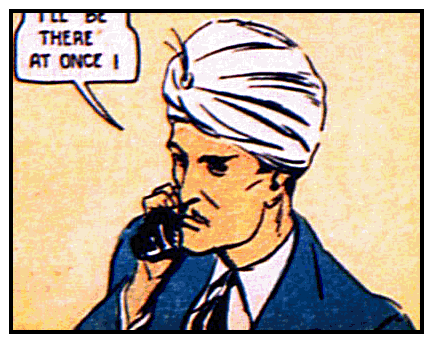 Nadir: 1937, New Adventures Comics #17. The "Master of Magic" is a prince of India but has turned his back on his royal title. His parents killed when he was young, he has devoted his life to the elimination of crime, well educated in the sciences and ways of the West as well as old secret knowledge of the Far East, ie some magic, hypnotism, and mental abilities. He uses a crystal ball and also knows jiu-jitsu. He lives in a penthouse, complete with his own lab, in New York with his Indian servant Arcot, and a favorite past-time when not fighting crime is playing chess. Nadir: 1937, New Adventures Comics #17. The "Master of Magic" is a prince of India but has turned his back on his royal title. His parents killed when he was young, he has devoted his life to the elimination of crime, well educated in the sciences and ways of the West as well as old secret knowledge of the Far East, ie some magic, hypnotism, and mental abilities. He uses a crystal ball and also knows jiu-jitsu. He lives in a penthouse, complete with his own lab, in New York with his Indian servant Arcot, and a favorite past-time when not fighting crime is playing chess.
Bruce Nelson: 1937, Detectie Comics #1. An independent adventurer/detective sort. Gets involved in fighting the Yellow Peril menace Sen Yoi.
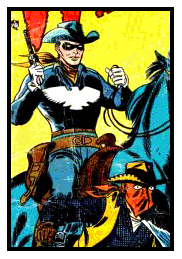 Nighthawk: 1948, Western Comics #5. In the Old West, Hannibal Hawkes was a roving tinkerer, going from town to town in his wagon and fixing things for people. However, he was also the costumed, masked Lone Ranger-esque hero Nighthawk. He briefly had a teen side-kick in Jim Peyton who was orphaned when his parents were killed by outlaws. Nighthawk: 1948, Western Comics #5. In the Old West, Hannibal Hawkes was a roving tinkerer, going from town to town in his wagon and fixing things for people. However, he was also the costumed, masked Lone Ranger-esque hero Nighthawk. He briefly had a teen side-kick in Jim Peyton who was orphaned when his parents were killed by outlaws.
Barry O'Neill: 1935, New Fun #1 (National/DC). Barry is an independently wealthy adventurer who gets drawn into intrigue and lengthy battle with the yellow peril menace Fang Gow. With the aid of his assistant Le Grand, they eventually defeat Fang Gow and other menaces.
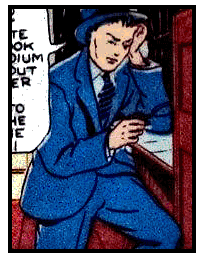 Punch Parker: 1941, World's Best Comics #1. Punch is a tough as nails plain clothes detective. Punch Parker: 1941, World's Best Comics #1. Punch is a tough as nails plain clothes detective.
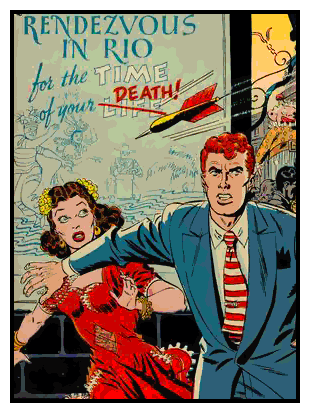 Johnny Peril: 1947, Comic Cavalcade #19. Johnny is an adventurous young man, sometimes listed as being a reporter. His stories and adventures take him all around the world. In his first appearance, he is only known as Mr. Nobody. It's in Comic Cavalcade #20 that he is named. NOTE: Johnny Peril would pop up almost every decade as a continuing character in books such as Sensation Mystery, The Unexpected, and Eclipso. Johnny Peril: 1947, Comic Cavalcade #19. Johnny is an adventurous young man, sometimes listed as being a reporter. His stories and adventures take him all around the world. In his first appearance, he is only known as Mr. Nobody. It's in Comic Cavalcade #20 that he is named. NOTE: Johnny Peril would pop up almost every decade as a continuing character in books such as Sensation Mystery, The Unexpected, and Eclipso.
Red Tornado: 1940, All-American Comics #20. Ma Hunkel decides to do something about crime in her neighborhood and puts on some long-johns, a cape and a pot on her head. She has no powers but is strong. Because of her hefty build and that the pot covers her whole head, she is often mistaken as a man. She's assisted by the Cyclone Kids who are her daughter Sisty and Sisty's friend Dinky Jibbet. A light-hearted strip by Sheldon Mayer. She is considered a founding member of the Justice Society of America on the technicality that she does show up briefly for their first meeting though she doesn't ever re-appear or help out in any of their subsequent stories.
Red, White, and Blue: 1939, All-American Comics #1. Sgt Red Dugan of the Marines, Whitey Smith of the Army and Blooey Blue of the Navy are pals since childhood from Oakville . They reunite in order to save Doris West who just happens to be G-2, an agent for the Secret Service who is on a case. She arranges for the three to be put on special duty and remain a team.
Bart Regan: (For DC) 1937, Detective Comics #1. Federal man Bart Regan debuted and appeared for all of one issue at The Comics Magazine #2 before running in Detective Comics. He's your standard G-Man.
Red Riley and Curley Moran: 1937, New Adventure Comics v2n2 (14). Red and Curley are two ex-Marines travelling in Asia seeking adventure and fortune by taking a job to run a tropical plantation. Unfortunately for them, someone doesn't want them to arrive, so they run afoul a hired killer, get thrown overboard, rescued and then find themselves the main line of defense of a captain against a mutinous crew. And, that's just the first installment! Interestingly, Red does not appear to have red hair. When Red gets angry though, he's more than capable of fighting off several tough men at a time.
Rod Rion: Rod is a Flash Gordon/Buck Rogers type of hero whose stories apparently first appeared in comic strip format (or at least distributed by a syndicate) and reprinted in comics by a couple of different publishers. He briefly appeared in Flash Comics. For more detail of the character, go to the general Golden-Age Heroes pages.
Robin: 1940, Detective Comics #38. Dick Grayson is a child acrobat from an acrobat family in a circus. He witnesses his parents fall to their deaths, an "accident" arranged by a gangster. He is taken in by the Batman who is already on the trail of the gangster. The child's already formidible physical skills allows him to become Batman's partner and help him bring his parents' killer to justice. He is privy to Batman's secret identity of Bruce Wayne and he becomes Wayne's legal ward and ongoing partner. He's skilled enough in fighting and detection, he even engages in solo cases.
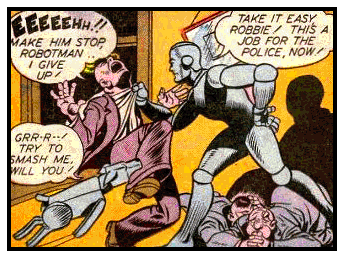 Robotman. 1942, Star-Spangled Comics #7. A group of thugs break into the lab of Dr Robert Crane and Dr. Chuck Grayson and Crane is shot when he tries to stop them. Fortunately, he and Grayson were working on a robotic humanoid body that could keep a human brain alive. Grayson puts Crane's brain into the robotic body. He makes a human life-like mask and creates a new identity as Paul Dennis. As Dennis, he gets up with his old girlfriend Joan Carter. He eventually builds a robotic dog with the ability to think, reason and talk who serves as sidekick and helps him in his crime fighting. He has the expected super strength, speed, bullet proof body, etc. Ran for several years into the 1950s and with a certain witty light-hearted back and forth between him and Robbie. Robotman. 1942, Star-Spangled Comics #7. A group of thugs break into the lab of Dr Robert Crane and Dr. Chuck Grayson and Crane is shot when he tries to stop them. Fortunately, he and Grayson were working on a robotic humanoid body that could keep a human brain alive. Grayson puts Crane's brain into the robotic body. He makes a human life-like mask and creates a new identity as Paul Dennis. As Dennis, he gets up with his old girlfriend Joan Carter. He eventually builds a robotic dog with the ability to think, reason and talk who serves as sidekick and helps him in his crime fighting. He has the expected super strength, speed, bullet proof body, etc. Ran for several years into the 1950s and with a certain witty light-hearted back and forth between him and Robbie.
Rodeo Rick. 1948, Western Comics #1. Rodeo Rick and his horse Comet has adventures while entertaining in rodeos.
Roving Ranger: 1951, All-Star Western #58. Lone rider for justice in the Old West, though he doesn't wear a mask.
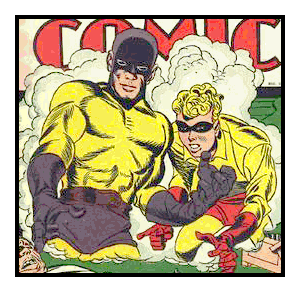 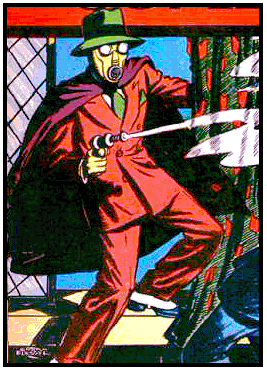 Sandman: 1939, New York World's Fair #1. Wesley Dodd is an idle millionaire who decides to fight crime. Talented in science, he builds himself an underground lab where he creates a gas gun that fires knockout gas. He puts together a pulpish costume of a regular suit, gloves, fedora, cape and complete with gas mask and starts fighting crime. His girlfriend is Dian Belmont. Later, Dian disappears from the strip but he gets a new yellow and purple costume and her nephew Sandy as a sidekick and loses the gas gun. During this phase, his stories often played with themes of dreams and nightmares.. The Sandman is a charter member of the Justice Society of America. NOTE: The yellow and purple costume is often called the Simon & Kirby costume. However, they came to the strip after the character had already made the switch. Chad Grothkopf is the artist that actually did the re-design. Sandman: 1939, New York World's Fair #1. Wesley Dodd is an idle millionaire who decides to fight crime. Talented in science, he builds himself an underground lab where he creates a gas gun that fires knockout gas. He puts together a pulpish costume of a regular suit, gloves, fedora, cape and complete with gas mask and starts fighting crime. His girlfriend is Dian Belmont. Later, Dian disappears from the strip but he gets a new yellow and purple costume and her nephew Sandy as a sidekick and loses the gas gun. During this phase, his stories often played with themes of dreams and nightmares.. The Sandman is a charter member of the Justice Society of America. NOTE: The yellow and purple costume is often called the Simon & Kirby costume. However, they came to the strip after the character had already made the switch. Chad Grothkopf is the artist that actually did the re-design.
Sandor: 1936, New Comics #5. Sandor is a jungle hero in the wilds of India, raised since childhood by wild dogs who now follow him. He has an enemy in the Rajah Marajah. He has a human friend in Benar, the fakir. Elaka is the lead dog of the pack, who is wounded and captured by the Raja, that Sandor risks life and limb to rescue.
Sargon: 1941, All-American Comics #26. The magical jewel Ruby of Life wandered from hand to hands before winding up on the necklace of the wife of an explorer. It was the first thing their baby saw and touched, which gave the child, John Sargent, the power over whatever he touches. As an adult, he becomes a crime fighting magician, his cover being of a performing stage magician. He is sidekicked by his manager Maximilian O'Leary. The sorceress the Blue Lama is a recurring foe of his.
Sandra of the Secret Service: 1935, New Fun #1. After stopping an assassination attempt, Sandra McLane (sometimes McClane) is invited to become a secret agent. As such, she is a good fighter, detective and planning and executing various stratagies and intrigues.
Speed Saunders: 1937, Detective Comics #1. Cyril “Speed” Saunders is a special operative in a uit of the River Patrol, though later he seems a regular police detective. In addition to regular cases with standard villains, a few take on more fantastic elements. It's established in one story that his mother is still living. During his down time, Speed enjoys smoking a pipe and lounging in a dressing gown reading including Detective Comics!
Scoop Scanlon: 1938, Action Comics #1. Scoop is a gun toting reporter who goes up against a range of villains and gets involved in plenty of gunfights. He is a reporter for The Bulletin from some un-named city. He is helped by his friend and photographer Rusty James. The two also appeared in New York World's Fair Comics #1
Shining Knight: 1941, Adventure Comics #66. Sir Justin is a knight of Camelot who sallies forth to fight an ogre. Successful, he rescues Merlin who rewards him with a magical suit of armor, sword, and winged horse called Winged Victory. Somehow, even with a flying horse, the duo fall into a crevasse and fall into suspended animation. He thaws in modern times at the beginning of WWII. He fights crime with his bulletproof armor, flying horse and super sharp sword. He's a founding member of the Seven Soldiers of Victory, arguably the most powerful of the team.
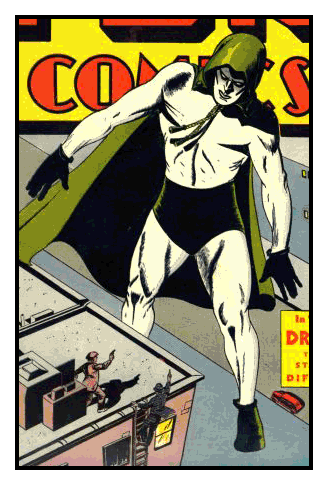 Spectre: 1942, More Fun Comics #52. Jim Corrigan is a cop who is slain in the line of duty. Instead of going to Heaven, he's sent back to Earth by the "Voice" to fight crime and supernatural menaces. He is still Corrigan, but ever present in his mind is that as Corrigan, he's not really alive. As the Spectre, he has vast powers, whatever the situation demands. Clarice Winston is Corrigan's old girlfriend. NOTE: In his first appearance, his cloak is a blue-gray instead of green. Spectre: 1942, More Fun Comics #52. Jim Corrigan is a cop who is slain in the line of duty. Instead of going to Heaven, he's sent back to Earth by the "Voice" to fight crime and supernatural menaces. He is still Corrigan, but ever present in his mind is that as Corrigan, he's not really alive. As the Spectre, he has vast powers, whatever the situation demands. Clarice Winston is Corrigan's old girlfriend. NOTE: In his first appearance, his cloak is a blue-gray instead of green.
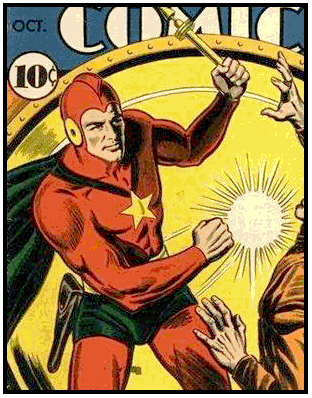 Starman: 1941, Adventure Comics #61. Ted Knight is an amateur astronomer and scientist. He invents the "gravity rod" which uses the power from distant stars (in some instances, it is powerless in daylight). In addition to allowing the bearer to negate gravity, he can use it to remotely affect electrical systems and various plot required devices. He uses this to fight crime. To his girlfriend Doris Lee, he pretends to be sickly, worn out by too much excitement, etc. He joins the Justice Society of America.. NOTE: By Gardner Fox and Jack Burnley, the Starman stories are amazingly well done, with solid plots, interesting villains, and well executed illustrative artwork that was better than most superhero comics. In the 1960s, he was in a couple of stories pairing him up with the Black Canary drawn by Murphy Anderson. Starman: 1941, Adventure Comics #61. Ted Knight is an amateur astronomer and scientist. He invents the "gravity rod" which uses the power from distant stars (in some instances, it is powerless in daylight). In addition to allowing the bearer to negate gravity, he can use it to remotely affect electrical systems and various plot required devices. He uses this to fight crime. To his girlfriend Doris Lee, he pretends to be sickly, worn out by too much excitement, etc. He joins the Justice Society of America.. NOTE: By Gardner Fox and Jack Burnley, the Starman stories are amazingly well done, with solid plots, interesting villains, and well executed illustrative artwork that was better than most superhero comics. In the 1960s, he was in a couple of stories pairing him up with the Black Canary drawn by Murphy Anderson.
Star-Spangled Kid & Stripesy: 1941, Star-Spangled Comics #1. Bookish Sylvester Pemberton proves to have a streak of patriotic iron in him and after he and Pat Dugan break up a pro-German bund, the two decide to team up and fight criminals against America as the Star-Spangled Kid and Stripesy. Pat is hired on by the Pemberton family as chauffeur and mechanic. The two build the Star Racer a flying car. They are founding members of The Seven Soldiers of Victory. Stripesy is played as being a bit of a big lug, but he shows a strong inventive streak. The strip is an interesting reversal where the kid is the main hero and the adult is the side kick. Stripesy is eventually wounded and replaced by Sylvester's step sister.
Captain Douglas Stewart: 1937, New Adventure Comics v2n2 (14). It is shortly after the War and Captain Stewart is in Paris awaiting his orders to return state-side. At a party he falls in love with Baroness Elsa Von Saxenberg, a lady in waiting to the Queen. At the same time he earns the enmity of a Count Kraft Von Bolander, a sympathizer of the Bolshevists. Wanting to marry her, but knowing all that awaits him is being discharged and looking for work, he decides instead to seek a fortune she tells him about, a treasure at the Monastary of the Blue God which her father died searching for. He arranges himself and his friend Sgt. Miller to be assigned to military intelligence and sent to Peking where he can begin his search. Elsa accompanies him on the trip. Stewart is brave, has a commanding voice that compels obedience, and is fluent in Chinese.
Socko Strong: 1939, Adventure #40. Joe Palooka type character, he's a strong good looking boxer. His pal is a bespectacled photographer. While he is a boxer, the strip is a bit more of an adventure strip that has a character whose job is as a boxer.
Super-Police: 1935, New Fun #1. Professor Shanley invents the “Hi-Lo”, a stratosphere plane/submarine which the Super-Police of 2023 use. The heroes are Rex Cosmo, the Professor, his daughter Joan and Axel Yoke. They travel the world solving crimes and mysteries, though ostensibly, they are American. Rex and the Professor try to keep Joan out of the adventures because they are “too dangerous” but she's more apt to kill herself through her attempts to stow away. They receive SOS messages on the “photolight”. Captain Kiddlaw is one of their opponents.
Tad and the Pirates: 1935, New Fun #1. In the year 1735, the boy Tad finds himself amongst pirates aboard ship. NOTE: The strip was done so you'd cut it out and make your own cartoon, as if a silent film.
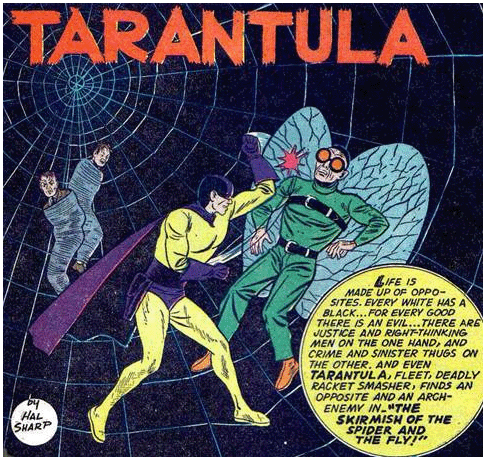
Tarantula: 1941, Star-Spangled Comics #1. Mystery author John Law decides to use the ideas he comes up with in his books to actually do something about the crime-wave. He creates a web-gun that fires a stream of liquid that solidifies to a web-like substance and he outfits his gloves and soles with suction cups that allow him to walk on walls and ceilings. His name and tools are inspired by his pet tarantula. His housekeeper Olga knows his secret. His first foe is a master criminal called Ace-Deuce. He also fights criminals with names like the Fly, Crime Candle, and the Blade.
Johnny Thunder: 1940, Flash Comics #1. Johnny Thunder is born to Simon B. and Mildred Thunder. Because he's considered a child of destiny, he's kidnapped by Badhnisians, given sacred rites and fated to become the most powerful person in the world at age 7. He's reunited with his parents and grows up to be a rather happy go lucky sort. When he says, “Cei-u”, prounced “Say you”, magical things happen around him for about an hour, making his wishes comes true. For some time, he doesn't know why it happens or what the magic words are. Eventually, he becomes aware of a pink thunderbolt is responsible, and then that it's actually a genie that he commands as it becomes more humanoid in appearance. However, he still calls on the Thunderbolt by accident more often than not. The Thunderbolt is arguably more intelligent than his master, but likes him and is willing to stretch the rules a little bit if it allows him to help Johnny. Johnny tends to have trouble holding down a job, his magic getting him into almost as much trouble as out. Despite this, he's a founding and long lasting member of the Justice Society of America and his girlfriend is Daisy Peach. When War breaks out, he enlists in the Navy. Late in his career, he teamed up with the novice heroine Black Canary who eventually replaced him in his own strip and in the JSA.
Johnny Thunder (II): 1948, All-American Comics #100. John Tane is torn between honoring the wishes of both parents. He made a promise to his dying mother to not take up guns but spread knowledge as a school teacher. However, his father wants him to be a man's man, to stand up and fight for what's right, even at the end of a gun. So, he changes the color of his hair and puts on cowboy duds to fight crime as Johnny Thunder (making him a cowboy version of Black Canary, so there's a little apropos in the name choice). His horse is Black Lightning...given DC's mania for declaring every character with the same name either related or a legacy no matter how torturous the logic, what does this say about Jefferson Pierce?.
Ultra-Man: 1939, All-American Comics #8. When Gary Concord loses his parents in WWI, he vows to wipe out war. By 1950, he has created a chemical that is so powerful it would frighten mankind to peace. However, another war breaks out and in a bombing raid in the U.S., his lab is blown up and Gary is chemically thrust into suspended animation. He wakes in 2174 to a world engulfed in war. Gary has undergone a transformation as well, taller than most men and superior strength. He uses his knowledge and new talents to bring about peace. His son, Gary Jr., inherits his father's stature and strength, becomes caretaker of his father's formula and continues the fight for peace as Ultra-Man.
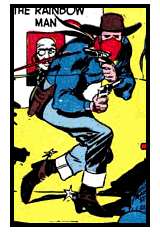 Vigilante: 1941, Action Comics #42. Greg Sanders starts off as a rodeo cowboy and morphs into a singing cowboy on the radio. He moonlights as the crimefighting Vigilante. He's good with his guns and the rope. Unlike many cowboy heroes, even the modern ones, the Vigilante eschews horses for the motocycle when doing his crime busting. He is sidekicked by an older cowboy by the name of Billy Gunn and Stuff, the Chinatown kid. His most notable villain is the Dummy, a midget who happens to look like a ventriloquist's dummy. The Vigilante is also a member of the Law's Legionnaires aka Seven Soldiers of Victory. NOTE: Drawn by Mort Meskin, one of the better looking cowboy heroes of the day. He also had his own movie serial played by Ralph Byrd. Vigilante: 1941, Action Comics #42. Greg Sanders starts off as a rodeo cowboy and morphs into a singing cowboy on the radio. He moonlights as the crimefighting Vigilante. He's good with his guns and the rope. Unlike many cowboy heroes, even the modern ones, the Vigilante eschews horses for the motocycle when doing his crime busting. He is sidekicked by an older cowboy by the name of Billy Gunn and Stuff, the Chinatown kid. His most notable villain is the Dummy, a midget who happens to look like a ventriloquist's dummy. The Vigilante is also a member of the Law's Legionnaires aka Seven Soldiers of Victory. NOTE: Drawn by Mort Meskin, one of the better looking cowboy heroes of the day. He also had his own movie serial played by Ralph Byrd.
“Wing” Walker: 1936, New Fun #2. Wing is a test pilot who gets grounded on trumped up charges and ends up running afoul of a couple of gangs of crooks who need a good pilot.
Chuck Warren: 1939, New York World's Fair Comics #1. Reader Helmutt Schoetter shares: "Titled Chuck Warren Goes To The New York World's Fair, it featured Chuck and the Catonah College track team. If the boys win on Saturday in the Tri-State Meet they might get a chance to participate in the World's Fair Meet. Chuck cheers on teammate Eddie in the Mile Relay while he waits as anchorman. Third man out Joe Carr is elbowed by an opponent and is fifteen yards behind when he hands the baton off to Chuck. "Chuck put on his famed lightning sprint" and won of course. Two days later the boys find out they will be racing at the fair but because the college can't afford to pay their way Chuck will have to drive them down.
On the way they realise that a bridge is out so Chuck has to jump the bridge. The boys stop for the night but the innkeeper only has room for three so Chuck and Joe sleep outside. Chuck dreams he is being kissed by an attractive brunette co-ed who I assume was or would have been his love interest. As they are about to get some breakfast next morning the boys realise that the bank has just been robbed. Chuck rams his car into the bank robbers car and helps capture them. The townspeople are so greatful they pay for the teams' train fare and will fix the car for free.
The team wins at the fair and Chuck sets a new record He is then congratulated by competitor Glenn Cunningham. I don't know if this was a real person or not or just a DC character but it seemed significant to me. The boys get "handsome watches with the World's Fair emblem" and also get a week at the fair free for "putting old Catonah College on the map". Seems the college found the money after all.
There is a Katonah in down state New York. Probably the writer was aware of this and just changed the first letter."
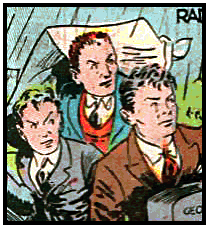 Les Watts: 1940, Flash Comics #12. Les is a teen (old enough to drive and fly his own light plane) and along with his pals, an avid amateur radio hobbyist. Naturally he gets into adventures fighting criminals and solving mysteries such as “The Adventure of the Monster of the Tombs”. His best pal is a lad named Joe. Les is the one in the back in the photo with the brown hair. Les Watts: 1940, Flash Comics #12. Les is a teen (old enough to drive and fly his own light plane) and along with his pals, an avid amateur radio hobbyist. Naturally he gets into adventures fighting criminals and solving mysteries such as “The Adventure of the Monster of the Tombs”. His best pal is a lad named Joe. Les is the one in the back in the photo with the brown hair.
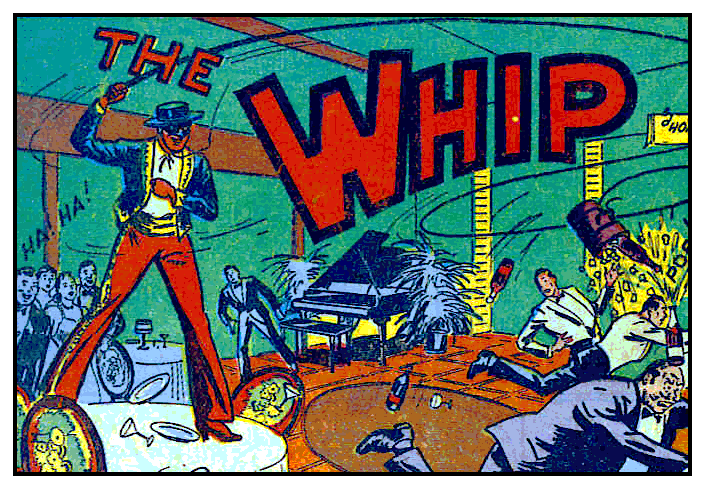 The Whip: 1940, Flash Comics #1. Learning of the famed 19th Century Don Fernando Suarez who fought for Justice and the oppressed as El Castigo aka The Whip, Easterner and polo player Rod Gaynor decides to become the modern day Whip to help the poor and oppressed in the American Southwest. Gaynor puts on a costume and affects a stereotypical Mexican accent and is already skilled in horseback riding. He is assisted by his Chinese valet Wing Tai. The Whip: 1940, Flash Comics #1. Learning of the famed 19th Century Don Fernando Suarez who fought for Justice and the oppressed as El Castigo aka The Whip, Easterner and polo player Rod Gaynor decides to become the modern day Whip to help the poor and oppressed in the American Southwest. Gaynor puts on a costume and affects a stereotypical Mexican accent and is already skilled in horseback riding. He is assisted by his Chinese valet Wing Tai.
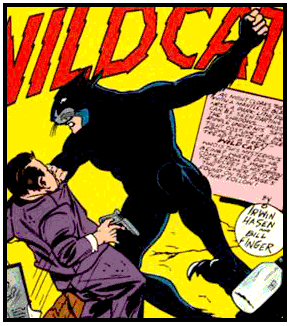 Wildcat: 1942, Sensation Comics #1. Meek Henry Grant makes sure that his son Ted Grant grows up to be strong of body as well as mind. Ted grows up to be a talented boxer but is duped into killing the former champ Socker Smith in the ring. He escapes from the Law and is on the run when he is inspired by a kid talking about his comic book hero Green Lantern who puts on a mask and costume to fight crime. So, he adopts the name of Wildcat to clear his name. He gains a comical sidekick in the long limbed Stretch Skinner who is his manager and fancies himself as a detective. He serves at least one case with the Justice Society of America. NOTE: His look is similar to MLJ's Fox which was also drawn by Irwin Hasen. Writer Bill Finger borrowed a lot from the pulps and the name is probably taken from the nickname of the pulp's Whisperer whose secret identity was Commissioner James “Wildcat” Gordon. In the very same issue, reading about Wildcat would inspire Little Boy Blue and the Blue Boys. Wildcat: 1942, Sensation Comics #1. Meek Henry Grant makes sure that his son Ted Grant grows up to be strong of body as well as mind. Ted grows up to be a talented boxer but is duped into killing the former champ Socker Smith in the ring. He escapes from the Law and is on the run when he is inspired by a kid talking about his comic book hero Green Lantern who puts on a mask and costume to fight crime. So, he adopts the name of Wildcat to clear his name. He gains a comical sidekick in the long limbed Stretch Skinner who is his manager and fancies himself as a detective. He serves at least one case with the Justice Society of America. NOTE: His look is similar to MLJ's Fox which was also drawn by Irwin Hasen. Writer Bill Finger borrowed a lot from the pulps and the name is probably taken from the nickname of the pulp's Whisperer whose secret identity was Commissioner James “Wildcat” Gordon. In the very same issue, reading about Wildcat would inspire Little Boy Blue and the Blue Boys.
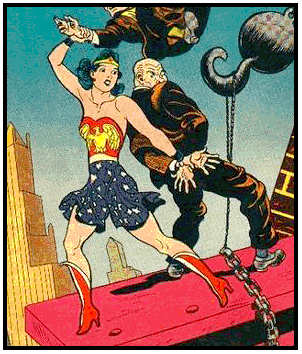 Wonder Woman: 1941, All-Star Comics #8. A plane carrying Captain Steve Trevor crashes on Paradise Island which is inhabited by an all female race of Amazons. Queen Hippolyte's daughter Diana has fallen for Steve and while he needs to be returned to the States, Diana is forbidden to lest she lose her eternal life. Hippolyte holds a contest of skills to select the proper Amazon for the task and Diana enters the contest masked and wins. Upon arrival to the U.S., she takes on the identity of nurse Diana Prince in order to stay close to Steve incognito. She is soon joined by a group of girl sidekicks, headed by the chubby Etta Candy. Wonder Woman joins the Justice Society of America. She's strong, fast, able to deflect bullets with her bracelets, and has the magic lasso that compels those it binds to tell the truth. When she's bound she loses her powers. NOTE: Many sources try to claim her as the first super-heroine or even hedge it by saying the first SIGNIFICANT or PROMINENT super-heroine. Such claims are defintely debatable and it all depends on how you want to parse the definitions. It is more accurate to claim her as the most significant or prominent superheroine of the age, but not first. For their companies and the time, Phantom Lady, Woman in Red, and Miss Victory are three of more who pre-date her, had decent runs and thus could be considered significant and prominent, even if largely unknown today. As written by William Marston and drawn by Harry G. Peter (Man O'Metal, Fearless Flint), her adventures often had a surreal quality to them, especially her Justice Society episodes next to the episodes of her team mates. Wonder Woman: 1941, All-Star Comics #8. A plane carrying Captain Steve Trevor crashes on Paradise Island which is inhabited by an all female race of Amazons. Queen Hippolyte's daughter Diana has fallen for Steve and while he needs to be returned to the States, Diana is forbidden to lest she lose her eternal life. Hippolyte holds a contest of skills to select the proper Amazon for the task and Diana enters the contest masked and wins. Upon arrival to the U.S., she takes on the identity of nurse Diana Prince in order to stay close to Steve incognito. She is soon joined by a group of girl sidekicks, headed by the chubby Etta Candy. Wonder Woman joins the Justice Society of America. She's strong, fast, able to deflect bullets with her bracelets, and has the magic lasso that compels those it binds to tell the truth. When she's bound she loses her powers. NOTE: Many sources try to claim her as the first super-heroine or even hedge it by saying the first SIGNIFICANT or PROMINENT super-heroine. Such claims are defintely debatable and it all depends on how you want to parse the definitions. It is more accurate to claim her as the most significant or prominent superheroine of the age, but not first. For their companies and the time, Phantom Lady, Woman in Red, and Miss Victory are three of more who pre-date her, had decent runs and thus could be considered significant and prominent, even if largely unknown today. As written by William Marston and drawn by Harry G. Peter (Man O'Metal, Fearless Flint), her adventures often had a surreal quality to them, especially her Justice Society episodes next to the episodes of her team mates.
Jack Woods: 1935, New Fun #1. Jack Woods is a cowboy hero, going from adventure to adventure possibly in the early 1900s. He starts off aiding Don Miguel and the Don's daughter Dolores against Mexican cattle rustlers. As the stories were serialized and only a couple pages long, this took awhile. In issue 19, it isrevealed that he is also a Texas Ranger but this detail is forgotten again after a few issues. He has a native servant named Indian Joe and a friend called Chuck but they only appear in one storyline each.
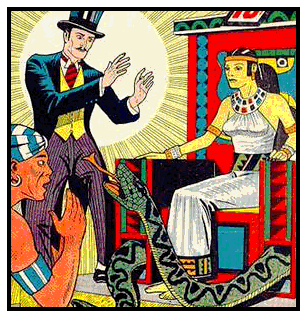 Zatara: 1939, Action Comics #1. John Zatara is a famous stage magician who uses that as cover for his real magical abilities that he uses to fight the forces of evil wherever he might find it. He has a femme fatale foe in the Tigress. While famous for his backwards speaking magic, his first appearance has him able to do magic without that trick. He's also sans mustache for awhile. Zatarra looked sharp as done by Fred Guardineer who had a magician hero at almost every company. Zatara: 1939, Action Comics #1. John Zatara is a famous stage magician who uses that as cover for his real magical abilities that he uses to fight the forces of evil wherever he might find it. He has a femme fatale foe in the Tigress. While famous for his backwards speaking magic, his first appearance has him able to do magic without that trick. He's also sans mustache for awhile. Zatarra looked sharp as done by Fred Guardineer who had a magician hero at almost every company. |
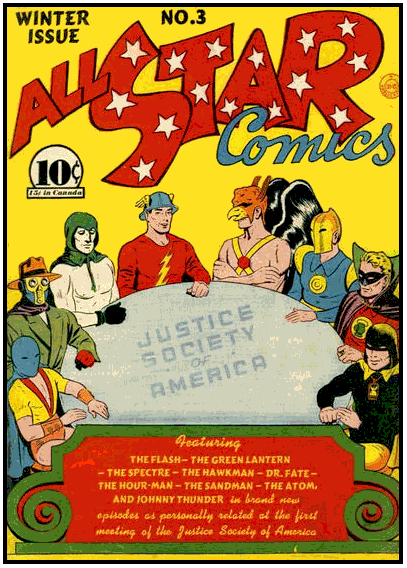
 Air Wave: 1942, Detective Comics #60. Air Wave is one of the heroes who is a lawyer in his normal identity and decides to also fight crime in a costume. In this case he's really D.A. Larry Jordan. He has no innate powers, but his costume has skates in the boots that allow him to cruise along power lines and such and he has radios in his ear pieces. He is partnered by the parrot Static who like many of the animal side-kicks, shows unusually high intelligence. He fought mostly normal criminals and spies but also a few more coloful foes such as the Talker, the Parrot, and Dr. Silence. Despite his relative obscurity today, he was a successful back-up hero, lasting for six years.
Air Wave: 1942, Detective Comics #60. Air Wave is one of the heroes who is a lawyer in his normal identity and decides to also fight crime in a costume. In this case he's really D.A. Larry Jordan. He has no innate powers, but his costume has skates in the boots that allow him to cruise along power lines and such and he has radios in his ear pieces. He is partnered by the parrot Static who like many of the animal side-kicks, shows unusually high intelligence. He fought mostly normal criminals and spies but also a few more coloful foes such as the Talker, the Parrot, and Dr. Silence. Despite his relative obscurity today, he was a successful back-up hero, lasting for six years. Atom: 1940, All-American Comics #19. Puny and short, Al Pratt is tired of being teased because of his five-foot-height and despondent over not impressing Mary, the girl of his dreams. He even buys a bum dinner just so he'll have someone to talk to. However, the bum turns out to be a former trainer of boxing agrees to train Al how to fight. A year of training on Al's uncle's farm, Al returns as a changed man: muscular, all around good athlete and excellent fighter. He ends up becoming a crime-fighter. He is a founding member of the Justice Society of America (and its most consistent member besides Hawkman), describing himself as a sophomore at Calvin College. When war breaks out, he enlists in the Tank Corps. He eventually gained real super-strength and changed his costume to reflect the more science fiction sensibilities as opposed to his athletic roots.
Atom: 1940, All-American Comics #19. Puny and short, Al Pratt is tired of being teased because of his five-foot-height and despondent over not impressing Mary, the girl of his dreams. He even buys a bum dinner just so he'll have someone to talk to. However, the bum turns out to be a former trainer of boxing agrees to train Al how to fight. A year of training on Al's uncle's farm, Al returns as a changed man: muscular, all around good athlete and excellent fighter. He ends up becoming a crime-fighter. He is a founding member of the Justice Society of America (and its most consistent member besides Hawkman), describing himself as a sophomore at Calvin College. When war breaks out, he enlists in the Tank Corps. He eventually gained real super-strength and changed his costume to reflect the more science fiction sensibilities as opposed to his athletic roots. Black Canary: 1947, Flash Comics #86 (DC). Raven haired flower shop owner Dinah Drake puts on a blonde wig and black costume to fight crime. She is a good fighter and knows judo. When she first debuts, she helps out the JSA member Johnny Thunder. Later, she often helps out private eye Larry Lance with his cases who is enamored with Black Canary, but only sees Dinah as a friend. She helps out the Justice Society (All-Star #38) and is made Honorary Member. Created by Robert Kanigher, Carmine Infantino, and Joe Giella. NOTE: Both in Flash Comics and the Justice Society stories in All-Star, she edged Johnny Thunder out.
Black Canary: 1947, Flash Comics #86 (DC). Raven haired flower shop owner Dinah Drake puts on a blonde wig and black costume to fight crime. She is a good fighter and knows judo. When she first debuts, she helps out the JSA member Johnny Thunder. Later, she often helps out private eye Larry Lance with his cases who is enamored with Black Canary, but only sees Dinah as a friend. She helps out the Justice Society (All-Star #38) and is made Honorary Member. Created by Robert Kanigher, Carmine Infantino, and Joe Giella. NOTE: Both in Flash Comics and the Justice Society stories in All-Star, she edged Johnny Thunder out.
 Wing Brady: 1935, New Fun #1. Wing Brady is with the French Foreign Legion and is helped in his adventures by his friend Slim. He can fly a plane, ride a horse, fight and shoot with the best of them.
Wing Brady: 1935, New Fun #1. Wing Brady is with the French Foreign Legion and is helped in his adventures by his friend Slim. He can fly a plane, ride a horse, fight and shoot with the best of them. Captain Desmo: 1938, New Adventure Comics #26. Captain Desmo is a heroic aviator. He was the youngest flyer in the First World War and continues to fly various missions that promise adventure. He stands out by constantly wearing an aviator's cap with a star on it, giving him a superhero type look at this early date. On one early mission he saves Gabby McGuire who becomes his sidekick. Major McAlistair of His Majesty's Lancers serves as contact for many of his missions most of which took place in India and the far East. For some unknown reason, Desmo wears his cowl all the time: on a mission, lounging in the house in casual clothes, asleep, etc. There seems to be a reason for it, as Gabby questions Desmo about it, but it remains unrevealed. Would think it would make things difficult when he's supposed to be undercover or investigating discretely. On the other hand, Gabby isn't much to talk as he wears his bowler hat even when bathing.
Captain Desmo: 1938, New Adventure Comics #26. Captain Desmo is a heroic aviator. He was the youngest flyer in the First World War and continues to fly various missions that promise adventure. He stands out by constantly wearing an aviator's cap with a star on it, giving him a superhero type look at this early date. On one early mission he saves Gabby McGuire who becomes his sidekick. Major McAlistair of His Majesty's Lancers serves as contact for many of his missions most of which took place in India and the far East. For some unknown reason, Desmo wears his cowl all the time: on a mission, lounging in the house in casual clothes, asleep, etc. There seems to be a reason for it, as Gabby questions Desmo about it, but it remains unrevealed. Would think it would make things difficult when he's supposed to be undercover or investigating discretely. On the other hand, Gabby isn't much to talk as he wears his bowler hat even when bathing. Young Doc Davis: 1941, World's Best Comics #1. Young Doc Davis is the new doctor at Metropolis Hospital which somehow leads to himself getting involved in solving mysteries, fighting yellow menaces and smuggling rings.
Young Doc Davis: 1941, World's Best Comics #1. Young Doc Davis is the new doctor at Metropolis Hospital which somehow leads to himself getting involved in solving mysteries, fighting yellow menaces and smuggling rings. Dr. Fate: 1940, More Fun Comics #55. When his father is killed exploring a pyramid, the boy Kent Nelson is raised by the alien sorcerer Nabu. When he reaches adulthood, he is a master of magic, occult and alchemy, able to covert energy into matter and vice versa. He lives in a forbidding brick tower in Salem Massachusetts. His girlfriend is Inza Kramer. Dr. Fate is a founding member of the JSA. NOTE: With his helmet and tights, Dr. Fate is one of the more striking and different looking magician heroes of the time.
Dr. Fate: 1940, More Fun Comics #55. When his father is killed exploring a pyramid, the boy Kent Nelson is raised by the alien sorcerer Nabu. When he reaches adulthood, he is a master of magic, occult and alchemy, able to covert energy into matter and vice versa. He lives in a forbidding brick tower in Salem Massachusetts. His girlfriend is Inza Kramer. Dr. Fate is a founding member of the JSA. NOTE: With his helmet and tights, Dr. Fate is one of the more striking and different looking magician heroes of the time. Johnny Everyman: 1944, World's Finest #15. During the War, Johnny operated mostly as an undercover agent. His adventures took him around the world, often facing/highlighting the issues facing various peoples and ethnicities. After the War, he tackled racial and cultural prejudices and bigotry at home, often telling inspiring stories to youths. Johnny had no powers but was a good fighter as well as a progressive thinker.
Johnny Everyman: 1944, World's Finest #15. During the War, Johnny operated mostly as an undercover agent. His adventures took him around the world, often facing/highlighting the issues facing various peoples and ethnicities. After the War, he tackled racial and cultural prejudices and bigotry at home, often telling inspiring stories to youths. Johnny had no powers but was a good fighter as well as a progressive thinker. Flash: 1940, Flash Comics #1. Jay Garrick is a college senior, and a bit on the slackard side, to be honest. He's a bench warmer on the Football Squad. And, even though he's a brilliant chemistry student it's against the coach's orders, he takes a break while separating the elements of “hard water” for a chemistry experiment to smoke a cigarrette. He accidentally knocks over the experiment and breathes in the vapors which knocks him unconscious. When he finally recovers, he discovers he has super speed which he first uses to show off and impress his girlfriend Joan Williams such as winning a football game pretty much by himself. Upon graduating from college, he finds a purpose in using his gift of super speed in fighting crime and makes a name for himself. In the first several issues, he's inconsistent with protecting his identity. He often operates invisibly by moving super fast, and his actions being attributed to freakish winds or ghosts. However, he also performs publicly in his Garrick identity on the football field and setting outlandish records while rooting out gambling racketeers. His girlfriend Joan knows his identity and tells one person that Garrick is almost as fast as the Flash and it would not be fair for him to compete with other athletes. He is a founding member of the Justice Society of America.
Flash: 1940, Flash Comics #1. Jay Garrick is a college senior, and a bit on the slackard side, to be honest. He's a bench warmer on the Football Squad. And, even though he's a brilliant chemistry student it's against the coach's orders, he takes a break while separating the elements of “hard water” for a chemistry experiment to smoke a cigarrette. He accidentally knocks over the experiment and breathes in the vapors which knocks him unconscious. When he finally recovers, he discovers he has super speed which he first uses to show off and impress his girlfriend Joan Williams such as winning a football game pretty much by himself. Upon graduating from college, he finds a purpose in using his gift of super speed in fighting crime and makes a name for himself. In the first several issues, he's inconsistent with protecting his identity. He often operates invisibly by moving super fast, and his actions being attributed to freakish winds or ghosts. However, he also performs publicly in his Garrick identity on the football field and setting outlandish records while rooting out gambling racketeers. His girlfriend Joan knows his identity and tells one person that Garrick is almost as fast as the Flash and it would not be fair for him to compete with other athletes. He is a founding member of the Justice Society of America. Flying Fox: 1938, More Fun Comics #37. The Flying Fox is a heroic aviator type. His real name is Rex Darrell, a pilot and hired investigator of some sort whose adventures take him to the four corners of the globe. His aviator's cowl has fox-like ears, so he does have a costume of sorts.
Flying Fox: 1938, More Fun Comics #37. The Flying Fox is a heroic aviator type. His real name is Rex Darrell, a pilot and hired investigator of some sort whose adventures take him to the four corners of the globe. His aviator's cowl has fox-like ears, so he does have a costume of sorts. Green Arrow: 1941, More Fun Comics #73. Oliver Queen is an idle millionaire with an interest in Indian lore and artifacts. He travels to the remote Lost Mesa in the hope of obtaining such when he meets Roy Harper and Quoag. Roy was marooned and orphaned on Lost Mesa by a plane crash, the only other survivor being the family servant and Native American Quoag. While marooned, Roy trained himself to be an expert with bow and arrow. Oliver hooks up with the duo about the same time that crooks find Oliver. In the ensuing fight, Quoag is killed. Oliver and Roy continue to fight crime as Green Arrow and Speedy. They are both members of The Seven Soldiers of Victory. NOTE: The golden-age Green Arrow did not use trick arrows to a large degree. Also, his hair was brown while Speedy's was blonde. In 1958, Jack Kirby gave us the more Batman tripped out version of Green Arrow and with a new origin.
Green Arrow: 1941, More Fun Comics #73. Oliver Queen is an idle millionaire with an interest in Indian lore and artifacts. He travels to the remote Lost Mesa in the hope of obtaining such when he meets Roy Harper and Quoag. Roy was marooned and orphaned on Lost Mesa by a plane crash, the only other survivor being the family servant and Native American Quoag. While marooned, Roy trained himself to be an expert with bow and arrow. Oliver hooks up with the duo about the same time that crooks find Oliver. In the ensuing fight, Quoag is killed. Oliver and Roy continue to fight crime as Green Arrow and Speedy. They are both members of The Seven Soldiers of Victory. NOTE: The golden-age Green Arrow did not use trick arrows to a large degree. Also, his hair was brown while Speedy's was blonde. In 1958, Jack Kirby gave us the more Batman tripped out version of Green Arrow and with a new origin. Guerilla: 1943, Adventure #84. Mike Gibbs is a joking reporter stationed in Paris in 1940. When the Germans invade he befriends Marie Hwart, organizer of the local Underground. He sheds his old identity and is known only as the Guerilla, stalking Nazis and other Axis forces and serving as a symbol to those suffering under Axis tyranny. While the blurb to his story suggests that he is no longer known as Mike Gibbs, he doesn't wear a mask or costume and the name of the strip is "Mike Gibbs, Guerilla".
Guerilla: 1943, Adventure #84. Mike Gibbs is a joking reporter stationed in Paris in 1940. When the Germans invade he befriends Marie Hwart, organizer of the local Underground. He sheds his old identity and is known only as the Guerilla, stalking Nazis and other Axis forces and serving as a symbol to those suffering under Axis tyranny. While the blurb to his story suggests that he is no longer known as Mike Gibbs, he doesn't wear a mask or costume and the name of the strip is "Mike Gibbs, Guerilla". Hawkgirl: As Shiera Sanders: 1940, Flash Comics #1. When Shiera Sanders first appeared, it was as a supporting character and love interest of Carter Hall who is a reincarnation of Prince Khufu of ancient Egypt and she is supposed to be the reincarnation of Khufu's love (also originally named the very non-Egyptian name Shiera), both of whom were killed by Hath Set in those ancient days and who has also reincarnated. Shiera first appears in a variation of Hawkman's costume in All-Star Comics #5, 1941 as a ruse to trick some criminals and then to a masquerade ball in Flash Comics #24, 1941. From then, it became a semi-regular gig for her. As Hawkgirl, Shiera could fly. NOTE: Interestingly, the story in that issue of Flash Comics is called “Hawkwoman”.
Hawkgirl: As Shiera Sanders: 1940, Flash Comics #1. When Shiera Sanders first appeared, it was as a supporting character and love interest of Carter Hall who is a reincarnation of Prince Khufu of ancient Egypt and she is supposed to be the reincarnation of Khufu's love (also originally named the very non-Egyptian name Shiera), both of whom were killed by Hath Set in those ancient days and who has also reincarnated. Shiera first appears in a variation of Hawkman's costume in All-Star Comics #5, 1941 as a ruse to trick some criminals and then to a masquerade ball in Flash Comics #24, 1941. From then, it became a semi-regular gig for her. As Hawkgirl, Shiera could fly. NOTE: Interestingly, the story in that issue of Flash Comics is called “Hawkwoman”.
 Hawkman: 1940, Flash Comics #1. Archaeologist Carter Hall has a realistic dream that he's the reincarnation of Prince Khufu of ancient Egypt and that he and Khufu's love are killed by the priest Hath-Set. The next day he meets Shiera Sanders who looks just like Khufu's love as well as discovering that their murderer has likewise been reincarnated as Dr. Hastor. Using ancient knowledge, he is able to make himself a pair of wings and an anti-gravity belt made of “ninth metal” that will allow him to fly. He is an avid collector of ancient weapons and proficient in them. Thus equipped, sets forth to bring his murderer and other criminals to justice. In the early days, he wasn't above killing his opponents if he felt their crimes merited it. He was a founding member of the Justice Society of America and its most consistent member.
Hawkman: 1940, Flash Comics #1. Archaeologist Carter Hall has a realistic dream that he's the reincarnation of Prince Khufu of ancient Egypt and that he and Khufu's love are killed by the priest Hath-Set. The next day he meets Shiera Sanders who looks just like Khufu's love as well as discovering that their murderer has likewise been reincarnated as Dr. Hastor. Using ancient knowledge, he is able to make himself a pair of wings and an anti-gravity belt made of “ninth metal” that will allow him to fly. He is an avid collector of ancient weapons and proficient in them. Thus equipped, sets forth to bring his murderer and other criminals to justice. In the early days, he wasn't above killing his opponents if he felt their crimes merited it. He was a founding member of the Justice Society of America and its most consistent member.
 Tod Hunter: 1938, New Comics #27. Tod Hunter is the "Jungle Master" of the title. He's an explorer and hunter. He travels with his pal Tommy (who wears a monocle so you can tell them apart). They are searching for the "God of the Ruby Eye", legend because supposedly no one has seen this god or its people and lived.
Tod Hunter: 1938, New Comics #27. Tod Hunter is the "Jungle Master" of the title. He's an explorer and hunter. He travels with his pal Tommy (who wears a monocle so you can tell them apart). They are searching for the "God of the Ruby Eye", legend because supposedly no one has seen this god or its people and lived. Liberty Belle: 1942, Boy Commandos #1. Libby Belle Lawrence is from Warsaw and finds herself fleeing country to country, ever one step ahead of the invading Nazis. By the time she reaches America, she's already famous for having swum the English Channel to escape France which she is able to parlay into a reporting gig. While vising the Liberty Bell, she's given a small replica by Tom Revere, a caretaker/watchman of the bell. She's motivated by the bell's symbol to create a costumed identity fashioned after the bell. When dangers and threats rear their heads, Tom rings the bell and through some kind of sympathetic magic connection, the replica she uses as a belt buckle vibrates. She doesn't wear a mask, relying on her eye-catching costume and Veronica Lake style haircut to serve as disguise enough.
Liberty Belle: 1942, Boy Commandos #1. Libby Belle Lawrence is from Warsaw and finds herself fleeing country to country, ever one step ahead of the invading Nazis. By the time she reaches America, she's already famous for having swum the English Channel to escape France which she is able to parlay into a reporting gig. While vising the Liberty Bell, she's given a small replica by Tom Revere, a caretaker/watchman of the bell. She's motivated by the bell's symbol to create a costumed identity fashioned after the bell. When dangers and threats rear their heads, Tom rings the bell and through some kind of sympathetic magic connection, the replica she uses as a belt buckle vibrates. She doesn't wear a mask, relying on her eye-catching costume and Veronica Lake style haircut to serve as disguise enough. Steve Malone: 1938, Detective Comics #18. Steve Malone is a suave DA and decent detective. He enjoys the finer things in life such as dressing in tux and tails for a night at the opera.
Steve Malone: 1938, Detective Comics #18. Steve Malone is a suave DA and decent detective. He enjoys the finer things in life such as dressing in tux and tails for a night at the opera. Manhunter (II): 1942, Adventure Comics #73. Paul Kirk is a big game hunter, is inspired by the death of Inspector Donovan. He decides to put on a costume and to use his skills to go after "the most dangerous game" - man, specifically criminals as well as enemy agents. He's called "Rick Nelson" at one point in the intro story, suggesting that name was changed after the fact, to link it to the previous Paul Kirk strip though the character isn't similar.
Manhunter (II): 1942, Adventure Comics #73. Paul Kirk is a big game hunter, is inspired by the death of Inspector Donovan. He decides to put on a costume and to use his skills to go after "the most dangerous game" - man, specifically criminals as well as enemy agents. He's called "Rick Nelson" at one point in the intro story, suggesting that name was changed after the fact, to link it to the previous Paul Kirk strip though the character isn't similar. Nadir: 1937, New Adventures Comics #17. The "Master of Magic" is a prince of India but has turned his back on his royal title. His parents killed when he was young, he has devoted his life to the elimination of crime, well educated in the sciences and ways of the West as well as old secret knowledge of the Far East, ie some magic, hypnotism, and mental abilities. He uses a crystal ball and also knows jiu-jitsu. He lives in a penthouse, complete with his own lab, in New York with his Indian servant Arcot, and a favorite past-time when not fighting crime is playing chess.
Nadir: 1937, New Adventures Comics #17. The "Master of Magic" is a prince of India but has turned his back on his royal title. His parents killed when he was young, he has devoted his life to the elimination of crime, well educated in the sciences and ways of the West as well as old secret knowledge of the Far East, ie some magic, hypnotism, and mental abilities. He uses a crystal ball and also knows jiu-jitsu. He lives in a penthouse, complete with his own lab, in New York with his Indian servant Arcot, and a favorite past-time when not fighting crime is playing chess.  Nighthawk: 1948, Western Comics #5. In the Old West, Hannibal Hawkes was a roving tinkerer, going from town to town in his wagon and fixing things for people. However, he was also the costumed, masked Lone Ranger-esque hero Nighthawk. He briefly had a teen side-kick in Jim Peyton who was orphaned when his parents were killed by outlaws.
Nighthawk: 1948, Western Comics #5. In the Old West, Hannibal Hawkes was a roving tinkerer, going from town to town in his wagon and fixing things for people. However, he was also the costumed, masked Lone Ranger-esque hero Nighthawk. He briefly had a teen side-kick in Jim Peyton who was orphaned when his parents were killed by outlaws. Punch Parker: 1941, World's Best Comics #1. Punch is a tough as nails plain clothes detective.
Punch Parker: 1941, World's Best Comics #1. Punch is a tough as nails plain clothes detective. Johnny Peril: 1947, Comic Cavalcade #19. Johnny is an adventurous young man, sometimes listed as being a reporter. His stories and adventures take him all around the world. In his first appearance, he is only known as Mr. Nobody. It's in Comic Cavalcade #20 that he is named. NOTE: Johnny Peril would pop up almost every decade as a continuing character in books such as Sensation Mystery, The Unexpected, and Eclipso.
Johnny Peril: 1947, Comic Cavalcade #19. Johnny is an adventurous young man, sometimes listed as being a reporter. His stories and adventures take him all around the world. In his first appearance, he is only known as Mr. Nobody. It's in Comic Cavalcade #20 that he is named. NOTE: Johnny Peril would pop up almost every decade as a continuing character in books such as Sensation Mystery, The Unexpected, and Eclipso. Robotman. 1942, Star-Spangled Comics #7. A group of thugs break into the lab of Dr Robert Crane and Dr. Chuck Grayson and Crane is shot when he tries to stop them. Fortunately, he and Grayson were working on a robotic humanoid body that could keep a human brain alive. Grayson puts Crane's brain into the robotic body. He makes a human life-like mask and creates a new identity as Paul Dennis. As Dennis, he gets up with his old girlfriend Joan Carter. He eventually builds a robotic dog with the ability to think, reason and talk who serves as sidekick and helps him in his crime fighting. He has the expected super strength, speed, bullet proof body, etc. Ran for several years into the 1950s and with a certain witty light-hearted back and forth between him and Robbie.
Robotman. 1942, Star-Spangled Comics #7. A group of thugs break into the lab of Dr Robert Crane and Dr. Chuck Grayson and Crane is shot when he tries to stop them. Fortunately, he and Grayson were working on a robotic humanoid body that could keep a human brain alive. Grayson puts Crane's brain into the robotic body. He makes a human life-like mask and creates a new identity as Paul Dennis. As Dennis, he gets up with his old girlfriend Joan Carter. He eventually builds a robotic dog with the ability to think, reason and talk who serves as sidekick and helps him in his crime fighting. He has the expected super strength, speed, bullet proof body, etc. Ran for several years into the 1950s and with a certain witty light-hearted back and forth between him and Robbie.
 Sandman: 1939, New York World's Fair #1. Wesley Dodd is an idle millionaire who decides to fight crime. Talented in science, he builds himself an underground lab where he creates a gas gun that fires knockout gas. He puts together a pulpish costume of a regular suit, gloves, fedora, cape and complete with gas mask and starts fighting crime. His girlfriend is Dian Belmont. Later, Dian disappears from the strip but he gets a new yellow and purple costume and her nephew Sandy as a sidekick and loses the gas gun. During this phase, his stories often played with themes of dreams and nightmares.. The Sandman is a charter member of the Justice Society of America. NOTE: The yellow and purple costume is often called the Simon & Kirby costume. However, they came to the strip after the character had already made the switch. Chad Grothkopf is the artist that actually did the re-design.
Sandman: 1939, New York World's Fair #1. Wesley Dodd is an idle millionaire who decides to fight crime. Talented in science, he builds himself an underground lab where he creates a gas gun that fires knockout gas. He puts together a pulpish costume of a regular suit, gloves, fedora, cape and complete with gas mask and starts fighting crime. His girlfriend is Dian Belmont. Later, Dian disappears from the strip but he gets a new yellow and purple costume and her nephew Sandy as a sidekick and loses the gas gun. During this phase, his stories often played with themes of dreams and nightmares.. The Sandman is a charter member of the Justice Society of America. NOTE: The yellow and purple costume is often called the Simon & Kirby costume. However, they came to the strip after the character had already made the switch. Chad Grothkopf is the artist that actually did the re-design. Spectre: 1942, More Fun Comics #52. Jim Corrigan is a cop who is slain in the line of duty. Instead of going to Heaven, he's sent back to Earth by the "Voice" to fight crime and supernatural menaces. He is still Corrigan, but ever present in his mind is that as Corrigan, he's not really alive. As the Spectre, he has vast powers, whatever the situation demands. Clarice Winston is Corrigan's old girlfriend. NOTE: In his first appearance, his cloak is a blue-gray instead of green.
Spectre: 1942, More Fun Comics #52. Jim Corrigan is a cop who is slain in the line of duty. Instead of going to Heaven, he's sent back to Earth by the "Voice" to fight crime and supernatural menaces. He is still Corrigan, but ever present in his mind is that as Corrigan, he's not really alive. As the Spectre, he has vast powers, whatever the situation demands. Clarice Winston is Corrigan's old girlfriend. NOTE: In his first appearance, his cloak is a blue-gray instead of green. Starman: 1941, Adventure Comics #61. Ted Knight is an amateur astronomer and scientist. He invents the "gravity rod" which uses the power from distant stars (in some instances, it is powerless in daylight). In addition to allowing the bearer to negate gravity, he can use it to remotely affect electrical systems and various plot required devices. He uses this to fight crime. To his girlfriend Doris Lee, he pretends to be sickly, worn out by too much excitement, etc. He joins the Justice Society of America.. NOTE: By Gardner Fox and Jack Burnley, the Starman stories are amazingly well done, with solid plots, interesting villains, and well executed illustrative artwork that was better than most superhero comics. In the 1960s, he was in a couple of stories pairing him up with the Black Canary drawn by Murphy Anderson.
Starman: 1941, Adventure Comics #61. Ted Knight is an amateur astronomer and scientist. He invents the "gravity rod" which uses the power from distant stars (in some instances, it is powerless in daylight). In addition to allowing the bearer to negate gravity, he can use it to remotely affect electrical systems and various plot required devices. He uses this to fight crime. To his girlfriend Doris Lee, he pretends to be sickly, worn out by too much excitement, etc. He joins the Justice Society of America.. NOTE: By Gardner Fox and Jack Burnley, the Starman stories are amazingly well done, with solid plots, interesting villains, and well executed illustrative artwork that was better than most superhero comics. In the 1960s, he was in a couple of stories pairing him up with the Black Canary drawn by Murphy Anderson.
 Vigilante: 1941, Action Comics #42. Greg Sanders starts off as a rodeo cowboy and morphs into a singing cowboy on the radio. He moonlights as the crimefighting Vigilante. He's good with his guns and the rope. Unlike many cowboy heroes, even the modern ones, the Vigilante eschews horses for the motocycle when doing his crime busting. He is sidekicked by an older cowboy by the name of Billy Gunn and Stuff, the Chinatown kid. His most notable villain is the Dummy, a midget who happens to look like a ventriloquist's dummy. The Vigilante is also a member of the Law's Legionnaires aka Seven Soldiers of Victory. NOTE: Drawn by Mort Meskin, one of the better looking cowboy heroes of the day. He also had his own movie serial played by Ralph Byrd.
Vigilante: 1941, Action Comics #42. Greg Sanders starts off as a rodeo cowboy and morphs into a singing cowboy on the radio. He moonlights as the crimefighting Vigilante. He's good with his guns and the rope. Unlike many cowboy heroes, even the modern ones, the Vigilante eschews horses for the motocycle when doing his crime busting. He is sidekicked by an older cowboy by the name of Billy Gunn and Stuff, the Chinatown kid. His most notable villain is the Dummy, a midget who happens to look like a ventriloquist's dummy. The Vigilante is also a member of the Law's Legionnaires aka Seven Soldiers of Victory. NOTE: Drawn by Mort Meskin, one of the better looking cowboy heroes of the day. He also had his own movie serial played by Ralph Byrd. Les Watts: 1940, Flash Comics #12. Les is a teen (old enough to drive and fly his own light plane) and along with his pals, an avid amateur radio hobbyist. Naturally he gets into adventures fighting criminals and solving mysteries such as “The Adventure of the Monster of the Tombs”. His best pal is a lad named Joe. Les is the one in the back in the photo with the brown hair.
Les Watts: 1940, Flash Comics #12. Les is a teen (old enough to drive and fly his own light plane) and along with his pals, an avid amateur radio hobbyist. Naturally he gets into adventures fighting criminals and solving mysteries such as “The Adventure of the Monster of the Tombs”. His best pal is a lad named Joe. Les is the one in the back in the photo with the brown hair. The Whip: 1940, Flash Comics #1. Learning of the famed 19th Century Don Fernando Suarez who fought for Justice and the oppressed as El Castigo aka The Whip, Easterner and polo player Rod Gaynor decides to become the modern day Whip to help the poor and oppressed in the American Southwest. Gaynor puts on a costume and affects a stereotypical Mexican accent and is already skilled in horseback riding. He is assisted by his Chinese valet Wing Tai.
The Whip: 1940, Flash Comics #1. Learning of the famed 19th Century Don Fernando Suarez who fought for Justice and the oppressed as El Castigo aka The Whip, Easterner and polo player Rod Gaynor decides to become the modern day Whip to help the poor and oppressed in the American Southwest. Gaynor puts on a costume and affects a stereotypical Mexican accent and is already skilled in horseback riding. He is assisted by his Chinese valet Wing Tai. Wildcat: 1942, Sensation Comics #1. Meek Henry Grant makes sure that his son Ted Grant grows up to be strong of body as well as mind. Ted grows up to be a talented boxer but is duped into killing the former champ Socker Smith in the ring. He escapes from the Law and is on the run when he is inspired by a kid talking about his comic book hero Green Lantern who puts on a mask and costume to fight crime. So, he adopts the name of Wildcat to clear his name. He gains a comical sidekick in the long limbed Stretch Skinner who is his manager and fancies himself as a detective. He serves at least one case with the Justice Society of America. NOTE: His look is similar to MLJ's Fox which was also drawn by Irwin Hasen. Writer Bill Finger borrowed a lot from the pulps and the name is probably taken from the nickname of the pulp's Whisperer whose secret identity was Commissioner James “Wildcat” Gordon. In the very same issue, reading about Wildcat would inspire Little Boy Blue and the Blue Boys.
Wildcat: 1942, Sensation Comics #1. Meek Henry Grant makes sure that his son Ted Grant grows up to be strong of body as well as mind. Ted grows up to be a talented boxer but is duped into killing the former champ Socker Smith in the ring. He escapes from the Law and is on the run when he is inspired by a kid talking about his comic book hero Green Lantern who puts on a mask and costume to fight crime. So, he adopts the name of Wildcat to clear his name. He gains a comical sidekick in the long limbed Stretch Skinner who is his manager and fancies himself as a detective. He serves at least one case with the Justice Society of America. NOTE: His look is similar to MLJ's Fox which was also drawn by Irwin Hasen. Writer Bill Finger borrowed a lot from the pulps and the name is probably taken from the nickname of the pulp's Whisperer whose secret identity was Commissioner James “Wildcat” Gordon. In the very same issue, reading about Wildcat would inspire Little Boy Blue and the Blue Boys.  Wonder Woman: 1941, All-Star Comics #8. A plane carrying Captain Steve Trevor crashes on Paradise Island which is inhabited by an all female race of Amazons. Queen Hippolyte's daughter Diana has fallen for Steve and while he needs to be returned to the States, Diana is forbidden to lest she lose her eternal life. Hippolyte holds a contest of skills to select the proper Amazon for the task and Diana enters the contest masked and wins. Upon arrival to the U.S., she takes on the identity of nurse Diana Prince in order to stay close to Steve incognito. She is soon joined by a group of girl sidekicks, headed by the chubby Etta Candy. Wonder Woman joins the Justice Society of America. She's strong, fast, able to deflect bullets with her bracelets, and has the magic lasso that compels those it binds to tell the truth. When she's bound she loses her powers. NOTE: Many sources try to claim her as the first super-heroine or even hedge it by saying the first SIGNIFICANT or PROMINENT super-heroine. Such claims are defintely debatable and it all depends on how you want to parse the definitions. It is more accurate to claim her as the most significant or prominent superheroine of the age, but not first. For their companies and the time, Phantom Lady, Woman in Red, and Miss Victory are three of more who pre-date her, had decent runs and thus could be considered significant and prominent, even if largely unknown today. As written by William Marston and drawn by Harry G. Peter (Man O'Metal, Fearless Flint), her adventures often had a surreal quality to them, especially her Justice Society episodes next to the episodes of her team mates.
Wonder Woman: 1941, All-Star Comics #8. A plane carrying Captain Steve Trevor crashes on Paradise Island which is inhabited by an all female race of Amazons. Queen Hippolyte's daughter Diana has fallen for Steve and while he needs to be returned to the States, Diana is forbidden to lest she lose her eternal life. Hippolyte holds a contest of skills to select the proper Amazon for the task and Diana enters the contest masked and wins. Upon arrival to the U.S., she takes on the identity of nurse Diana Prince in order to stay close to Steve incognito. She is soon joined by a group of girl sidekicks, headed by the chubby Etta Candy. Wonder Woman joins the Justice Society of America. She's strong, fast, able to deflect bullets with her bracelets, and has the magic lasso that compels those it binds to tell the truth. When she's bound she loses her powers. NOTE: Many sources try to claim her as the first super-heroine or even hedge it by saying the first SIGNIFICANT or PROMINENT super-heroine. Such claims are defintely debatable and it all depends on how you want to parse the definitions. It is more accurate to claim her as the most significant or prominent superheroine of the age, but not first. For their companies and the time, Phantom Lady, Woman in Red, and Miss Victory are three of more who pre-date her, had decent runs and thus could be considered significant and prominent, even if largely unknown today. As written by William Marston and drawn by Harry G. Peter (Man O'Metal, Fearless Flint), her adventures often had a surreal quality to them, especially her Justice Society episodes next to the episodes of her team mates. Zatara: 1939, Action Comics #1. John Zatara is a famous stage magician who uses that as cover for his real magical abilities that he uses to fight the forces of evil wherever he might find it. He has a femme fatale foe in the Tigress. While famous for his backwards speaking magic, his first appearance has him able to do magic without that trick. He's also sans mustache for awhile. Zatarra looked sharp as done by Fred Guardineer who had a magician hero at almost every company.
Zatara: 1939, Action Comics #1. John Zatara is a famous stage magician who uses that as cover for his real magical abilities that he uses to fight the forces of evil wherever he might find it. He has a femme fatale foe in the Tigress. While famous for his backwards speaking magic, his first appearance has him able to do magic without that trick. He's also sans mustache for awhile. Zatarra looked sharp as done by Fred Guardineer who had a magician hero at almost every company.